JKBOSE 10th Class Maths Solutions chapter – 5 Arithmetic Progressions
JKBOSE 10th Class Maths Solutions chapter – 5 Arithmetic Progressions
J&K 10th Class Maths Solutions chapter – 5 Arithmetic Progressions
Jammu & Kashmir State Board JKBOSE 10th Class Maths Solutions
INTRODUCTION
You must have observed that in nature, many things follow a certain pattern, such as the petals of a sunflower, the holes of a honeycomb, the grains on a maize cob, the spirals on a pineapple and on a pine cone etc.
In this chapter, we shall discuss patterns in which succeeding terms are obtained by adding a fixed number to the preceding terms. We shall also see how to find their nth terms and the sum of n consecutive terms, and use this knowledge in solving some daily life problems.
TEXT BOOK EXERCISE 5.1
Q. 1. In which of the following situations, does the list of numbers involved make an arithmetic progression, and why ?
(i) The taxi fare after each km when the fare is ₹ 15 for the first km and 8 for each additional km.
(ii) The amount of air present in a cylinder when a vacuum pump removes 1/4 of the air remaining in the cylinder at a time.
(iii) The cost of digging a well after every metre of digging, when it costs ₹ 150 for the first metre and rises by ₹ 50 for each subsequent metre.
(iv) The amount of money in the account every year when ₹ 10000 is deposited at compound interest at 8% per annum.
Solution.
(i) Let T denotes the taxi fare in nth km.
According to question,
T1 = 15 km; T2 = 15 + 8 = 23;
T3 = 23 + 8 = 31…………..
Now, T3 – T2 = 31 – 23 = 8
T2 – T1 = 23 – 15 = 8
Here, T3 – T2 = T2 – T1 = 8
∴ given situation form an A.P.
(ii) Let Tn denotes amount of air present in a cylinder.
According to question,
T1 = x ; T2 = x – 1/4 x
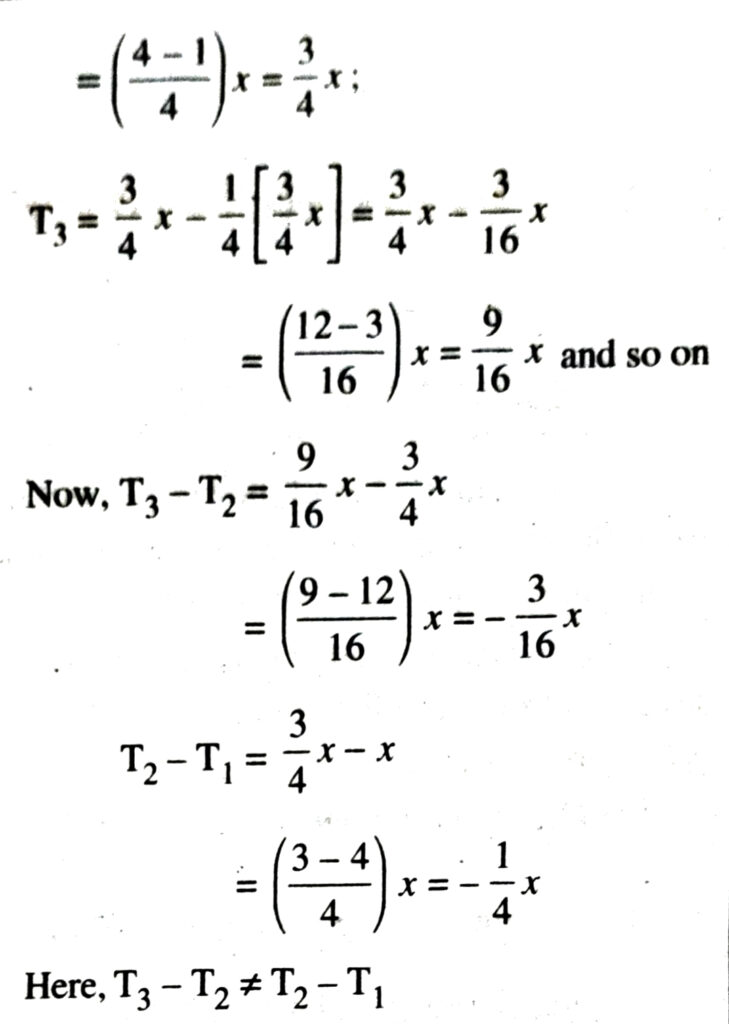
∴ given situation donot form an A.P.
(iii) Let Tn denotes cost of digging a well for n nth metre,
According to question,
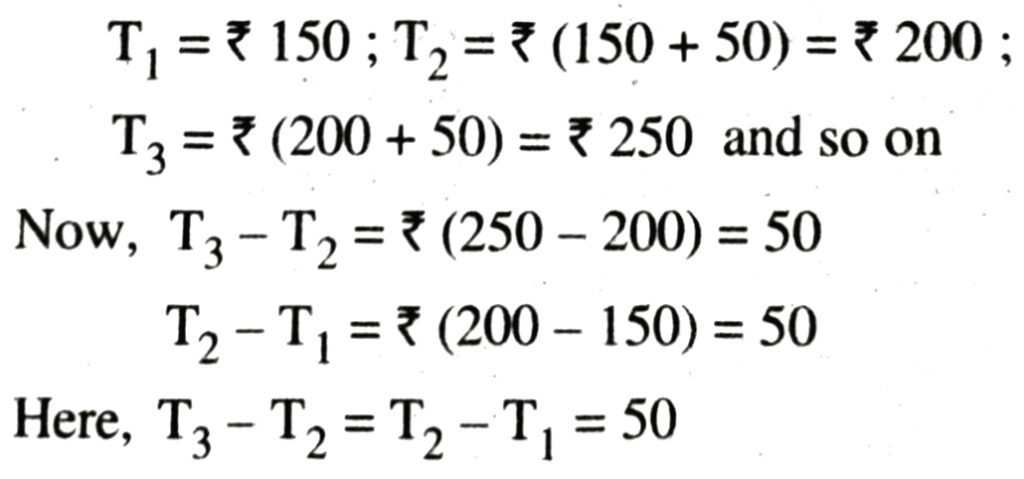
∴ given situtation form an A.P.
(iv) Let Tn denotes amount of money in the nth year.
According to question,
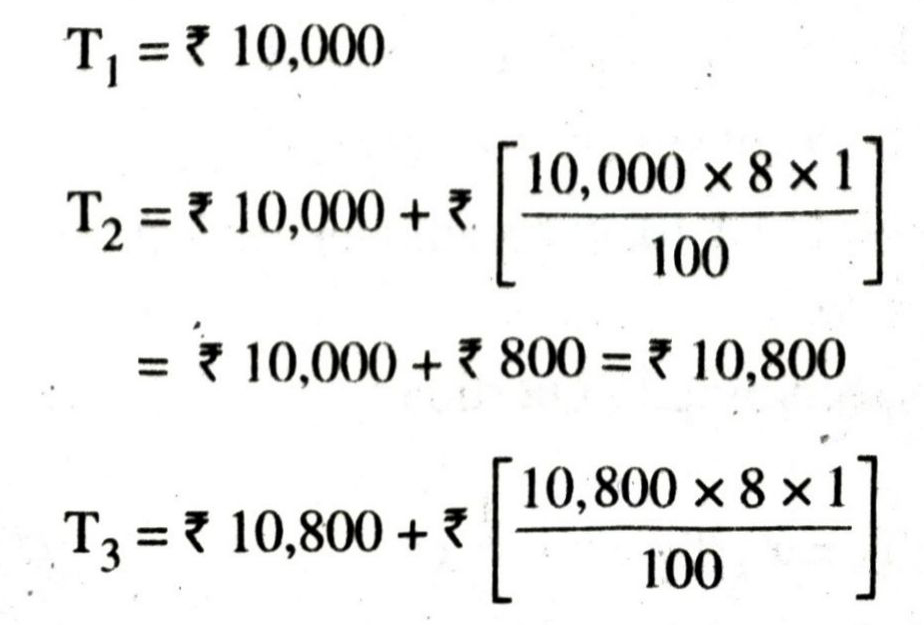
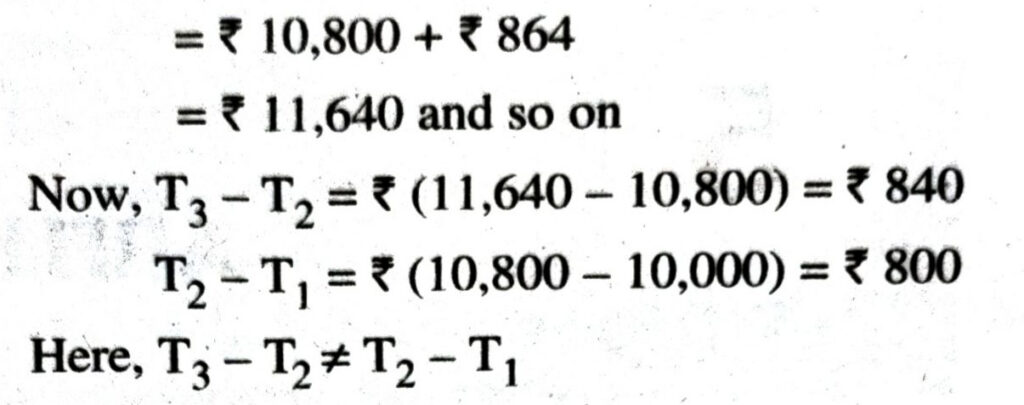
∴ given situation do not form an A.P.
Q. 2. Write first four terms of the A.P., when the first term a and the common difference d are given as follows:
(i) a = 10, d = 10
(ii) a = – 2, d = 0
(iii) a = 4, d = – 3
(iv) a = – 1, d = 1/2
(v) a = – 1.25, d = – 0.25
Solution. (i) Given that first term = a = 10
and common difference = d = 10
∴ T1 = a = 10;
T2 = a + d = 10 + 10 = 20;
T3 = a + 2d = 10 + 2 × 10 = 10 + 20 = 30;
T4 = a + 3d = 10 + 3 × 10 = 10 + 30 = 40
Hence, first four terms of an A.P. are
10, 20, 30, 40………
(ii) Given that first term = a = – 2
and common difference = d = 0
∴ T1 = a = -2;
T2 = a + d = – 2 + 0 = − 2
T3 = a + 2d = – 2 + 2 x 0 = – 2
T4 = a + 3d = – 2 + 3 x 0 = – 2
Hence, first four terms of an A.P. are
-2,-2,-2, – 2,…………
(iii) Given that first term = a = 4
and common difference = d=-3
∴ T1 = a = 4 ;
T2 = a + d = 4 – 3 = 1
T3 = a + 2d = 4 + 2(- 3) = 4 – 6 = – 2
T4 = a + 3d = 4 + 3 (- 3) = 4 – 9 = – 5
Hence, first four terms of an A.P. are
4, 1, – 2, – 5,…………
(iv) Given that first term = a = – 1
and common difference = d = 1/2
∴ T1 = a = -1;
T2 = a + d = – 1 + 1/2 = -1/2
T3 = a + 2d = – 1 + 2 (1/2)
= – 1 + 1 = 0
T4 = a + 3d = – 1 + 3 (1/2)
= -2+3/2 = 1/2.
Hence, first four terms of an A.P. are
-1, -1/2, 0, 1/2 ………
(v) Given that first term = a = – 1.25
and common difference = d = – 0.25
∴ T1 = a = – 1.25 ;
T2 = a + d = – 1.25 – 0.25 = – 1.50
T3 = a + 2d = – 1.25 + 2 (- 0.25) = – 1.25 – 0.50 = – 1.75
T4 = a +3d = – 1.25 + 3 (- 0.25) = – 1.25 – 0.75 = – 2
Hence, first four terms of an A.P. are
– 1.25, – 1.50, – 1.75, – 2, ……
Q.3. For the following A.P.s, write the first term and the common difference:
(i) 3, 1,-1,- 3, …
(ii) -5,-1, 3, 7, …
(iii) 1/3, 5/3, 9/3, 13/3…..
(iv) 0.6, 1.7, 2.8, 3.9, …
Solution. (i) Given A.P. is 3, 1,-1,- 3, ….

Hence, common difference = – 2 and first term = 3 Ans.
(ii) Given A.P. is

– 5, -1, 3, 7, …
Hence, common difference = 4 and first term = – 5 Ans.
(iii) Given A.P. is :

∴ T2 – T1 = T3 – T2 = T4 – T2 = 4/3
Hence, common difference = 4/3 and first term = 1/3 Ans.
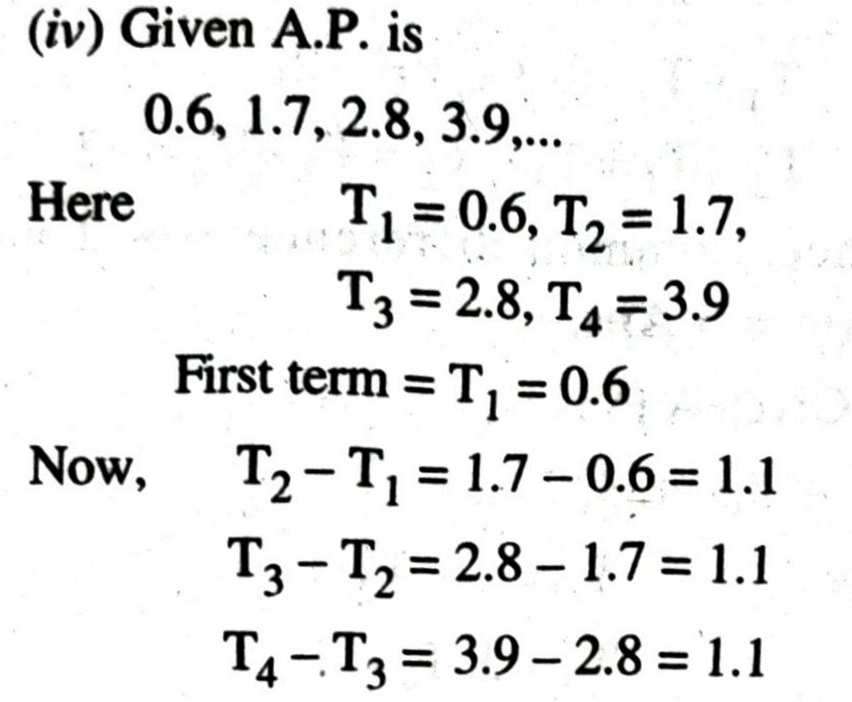
Hence, common difference = 1.1 and first term = 0.6 Ans.
Q. 4. Which of the following are A.P.’s? If they form an A.P., find the common difference d and write three more terms.


∴ Common difference=d=-2
Now, T5 = a + 4d = – 1.2 + 4 (- 2) = – 1.2 – 8 = – 9.2
T6 = a + 5d = -1.2 +5 (-2) = -1.2 – 10 = -11.2
T7 =a + 6d = -1.2 + 6 (-2) = -1.2 – 12 = -13.2
(iv) Given terms are
-10, -6, -2, 2, …
Here T1 = -10, T2 = -6,
T3 = -2, T4 = 2
T2 – T1 = -6 + 10 = 4
T3 – T1 = -2 + 6 = 4
T4 – T1 = 2 + 2 = 4
∵ T2 – T1 = T3 – T2 = T4 – T3 = 4
∴ Common difference = d = 4
Now, T5 = a + 4d = −10 + 4 (4) = -10 + 16 = 6
T6 = a + 5d = -10 + 5 (4) = -10 + 20 = 10
T7 = a + 6d = -10 + 6 (4) = – 10 + 24 = 14
(v) Given terms are
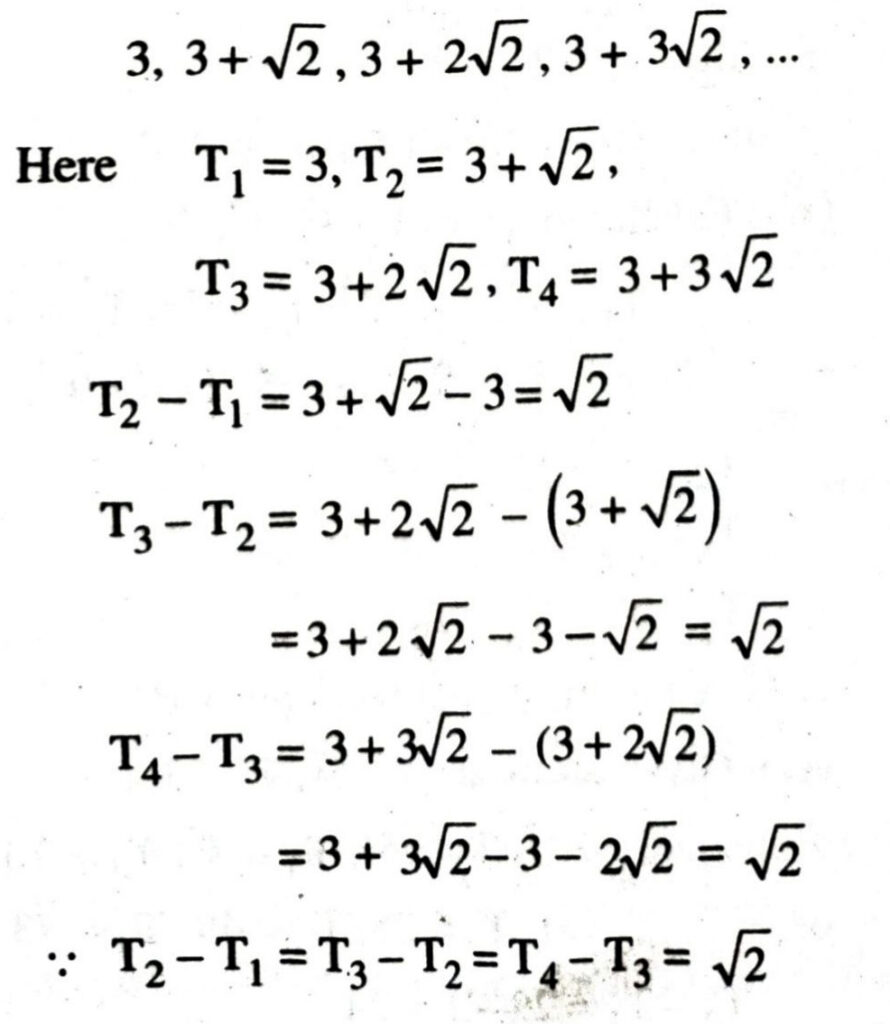



T3 – T2 = 49 – 24 = 24
T4 – T3 = 73 – 49 = 24
∵ T2 -T1 = T3 – T2 = T4 – T3 = 24
∴ Common difference = d = 24
T5 = a + 4d = 1 + 4 (24) = 1 + 96 = 97
T6 = a + 5d = 1 +5 (24) = 1 + 120 = 121
T7 = a + 6d = 1 + 6 (24) = 1 + 144 = 145
TEXT BOOK EXERCISE 5.2
Q. 1. Fill in the blanks in the following table, given that a is the first term, d the common difference and an the nth term of the A.P.:
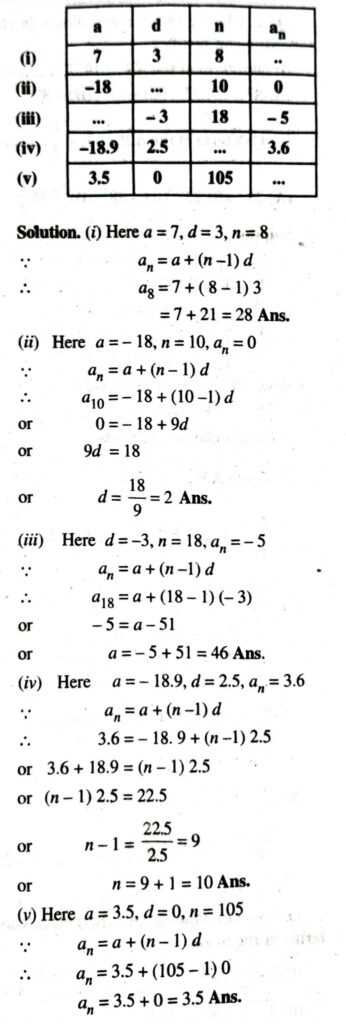
Q. 2. Choose the correct choice in the following and justify:
(i) 30th term of the A.P.: 10, 7, 4,…….is
(A) 97 (B) 77 (C)-77 (D)-87
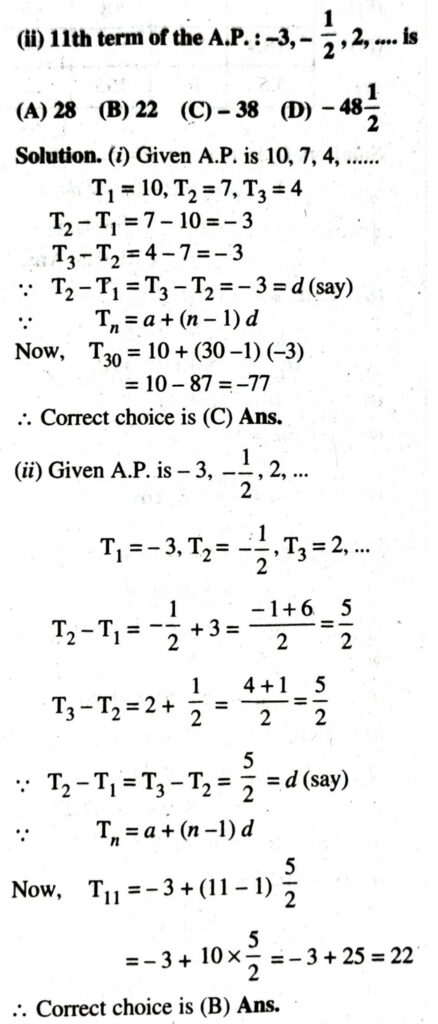
Q.3. In the following A.P.s, find the missing terms in the boxes:


Solution. Let ‘a’ be the first term and ‘d’ be the common difference of given A.P.
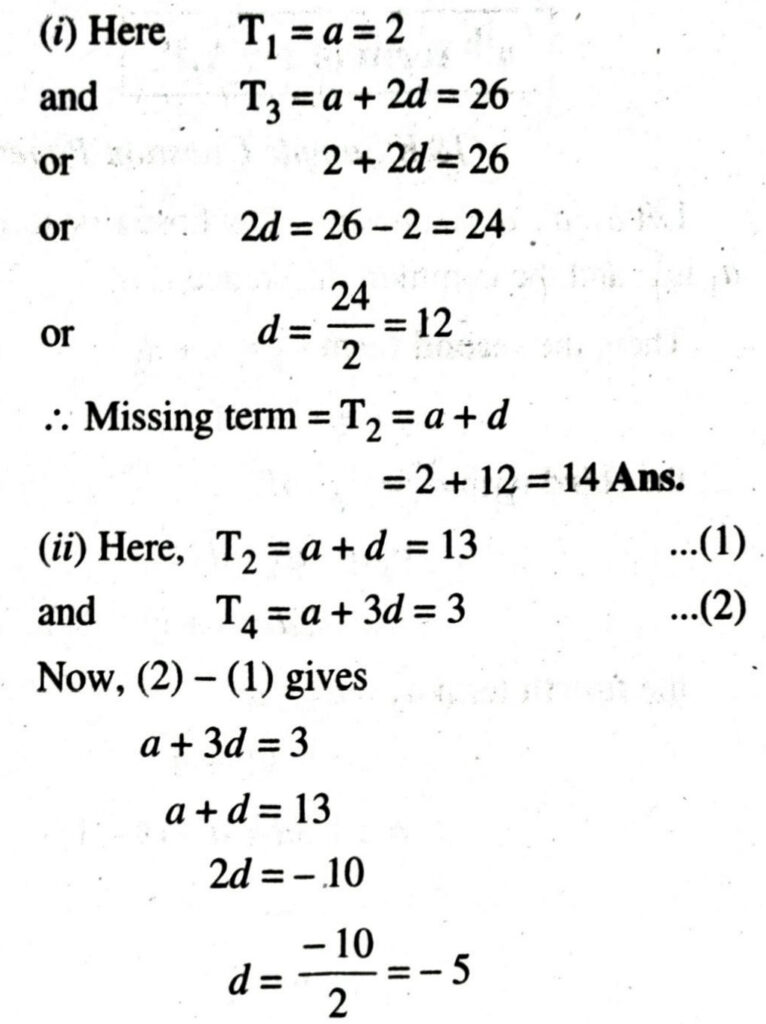
Substitute this value of d in (1), we get
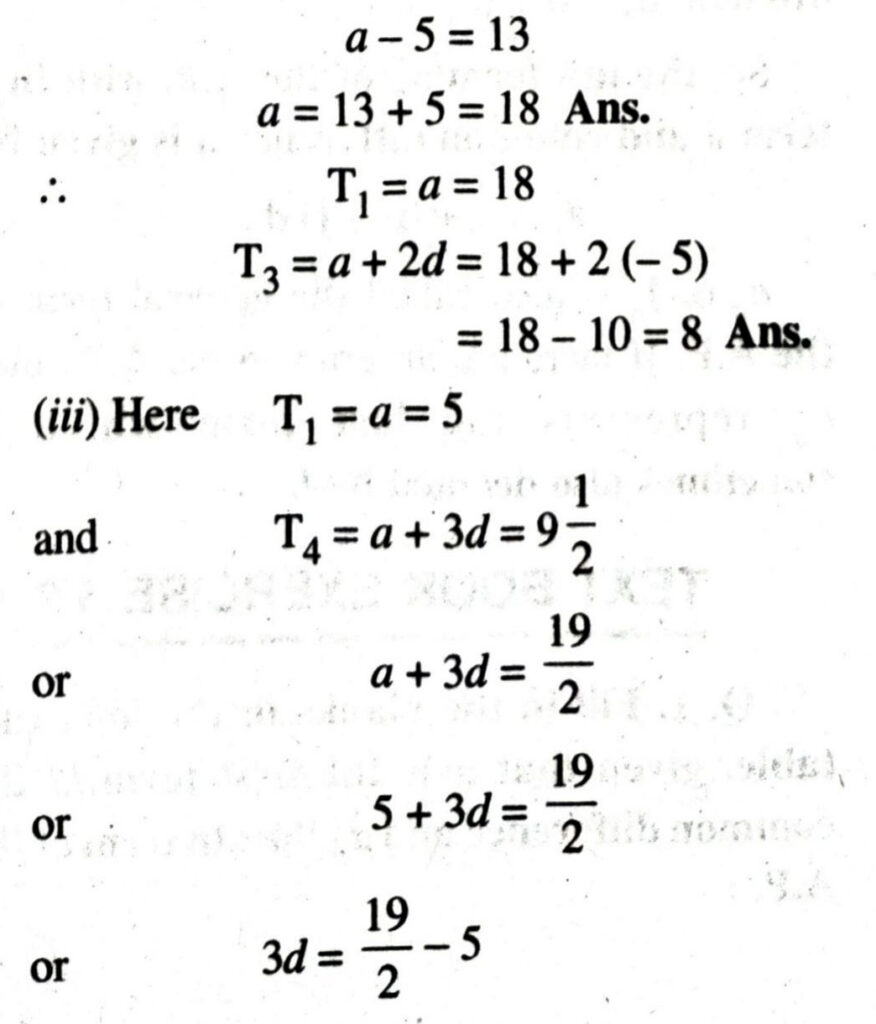

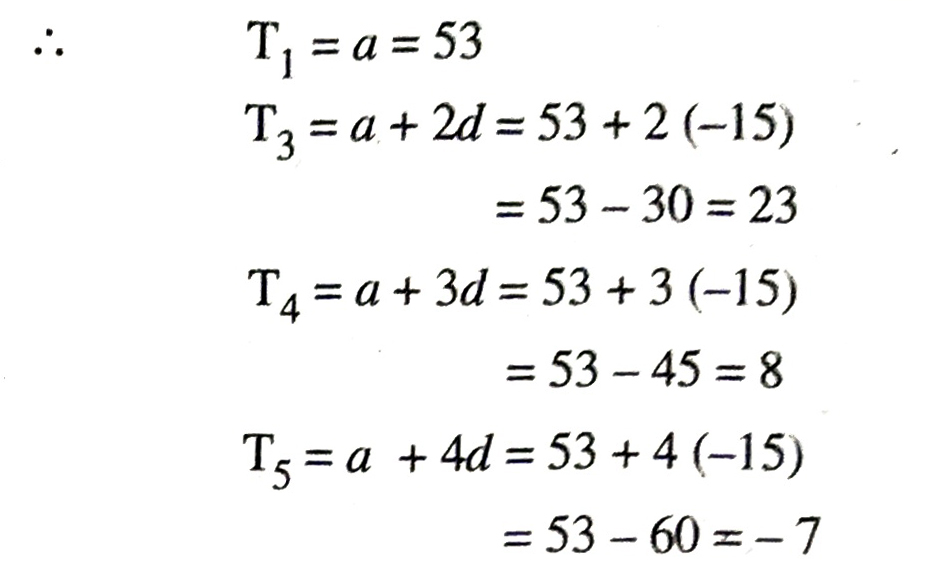
Q. 4. Which term of the A.P. 3, 8, 13, 18,….. is 78?

Q. 5. Find the number of terms in each of the following A.P.s :
(i) 7, 13, 19,…, 205
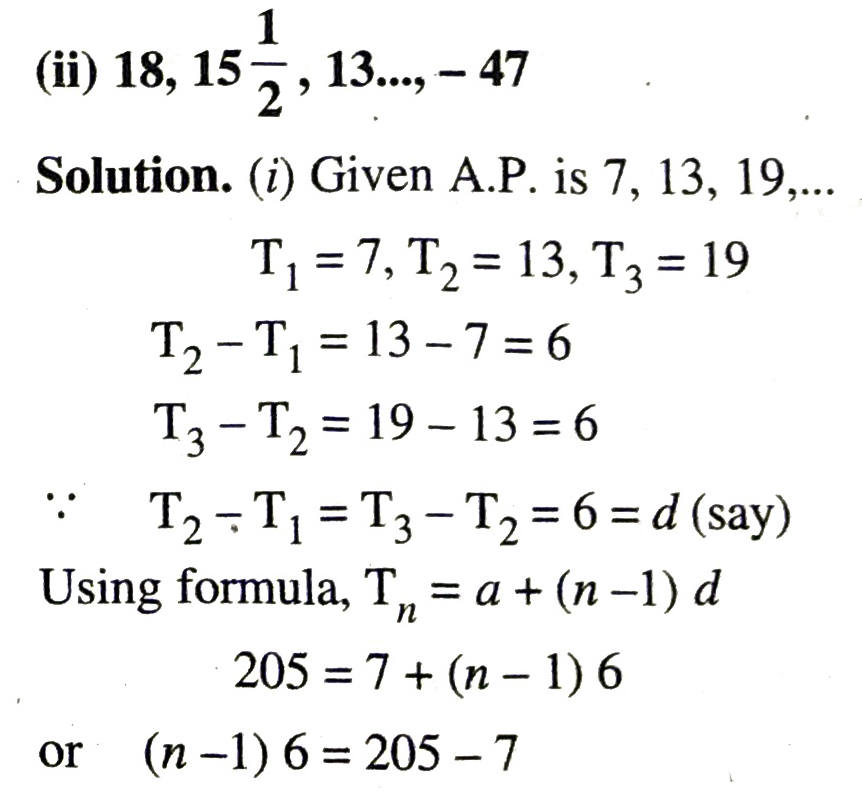
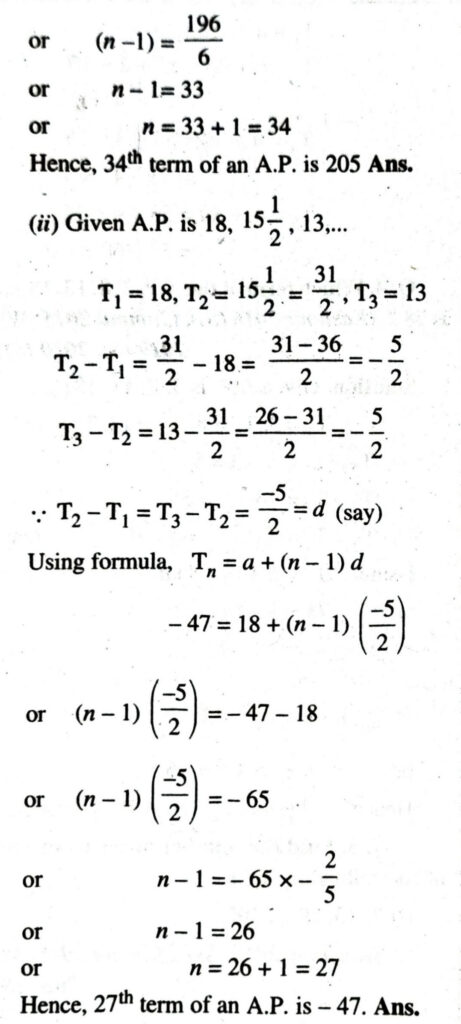
Q. 6. Is – 150 a term of 11, 8, 5, 2….? Why?
Solution. Given sequence is

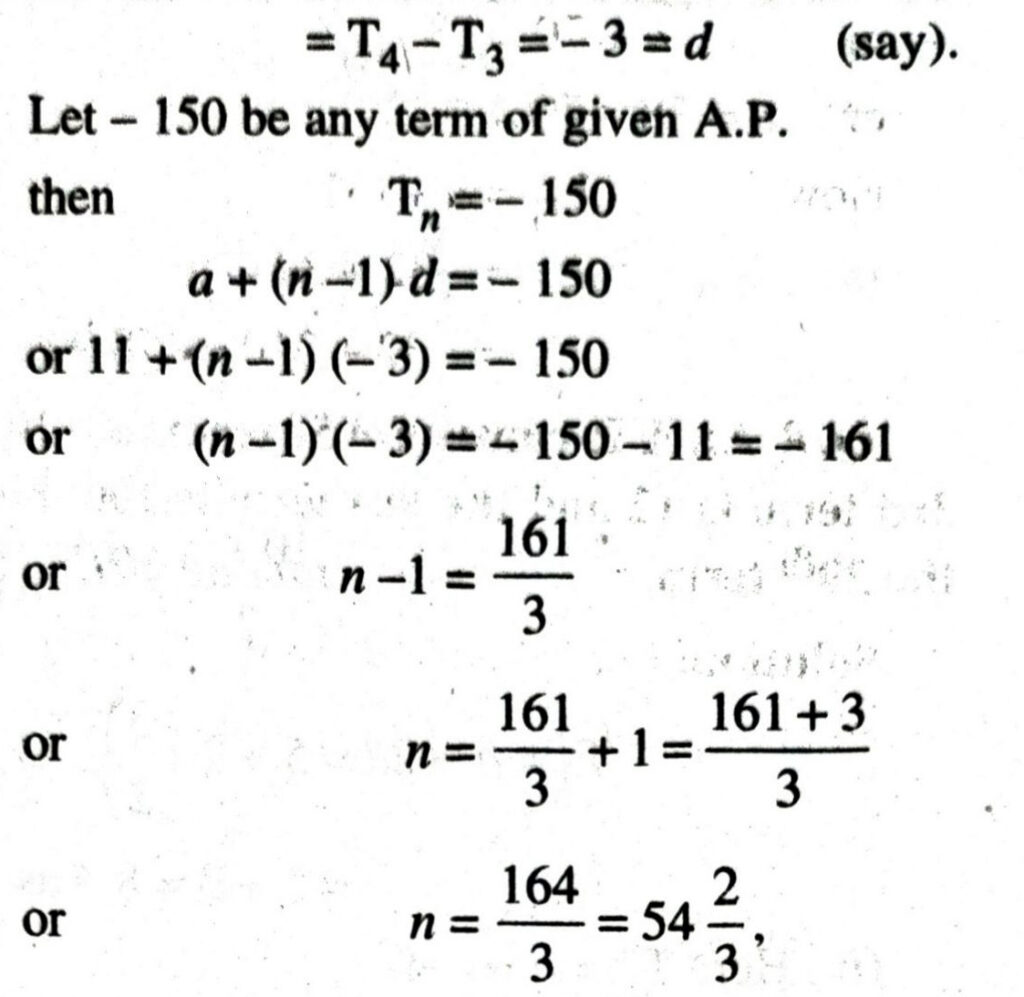
which is not a natural number.
Hence, – 150 cannot be a term of given A.P. Ans.
Q. 7. Find the 31st term of an A.P. whose 11th term is 38 and 16th term is 73.
Solution. Let ‘a’ and ‘d’ be the first term and common difference of given A.P.
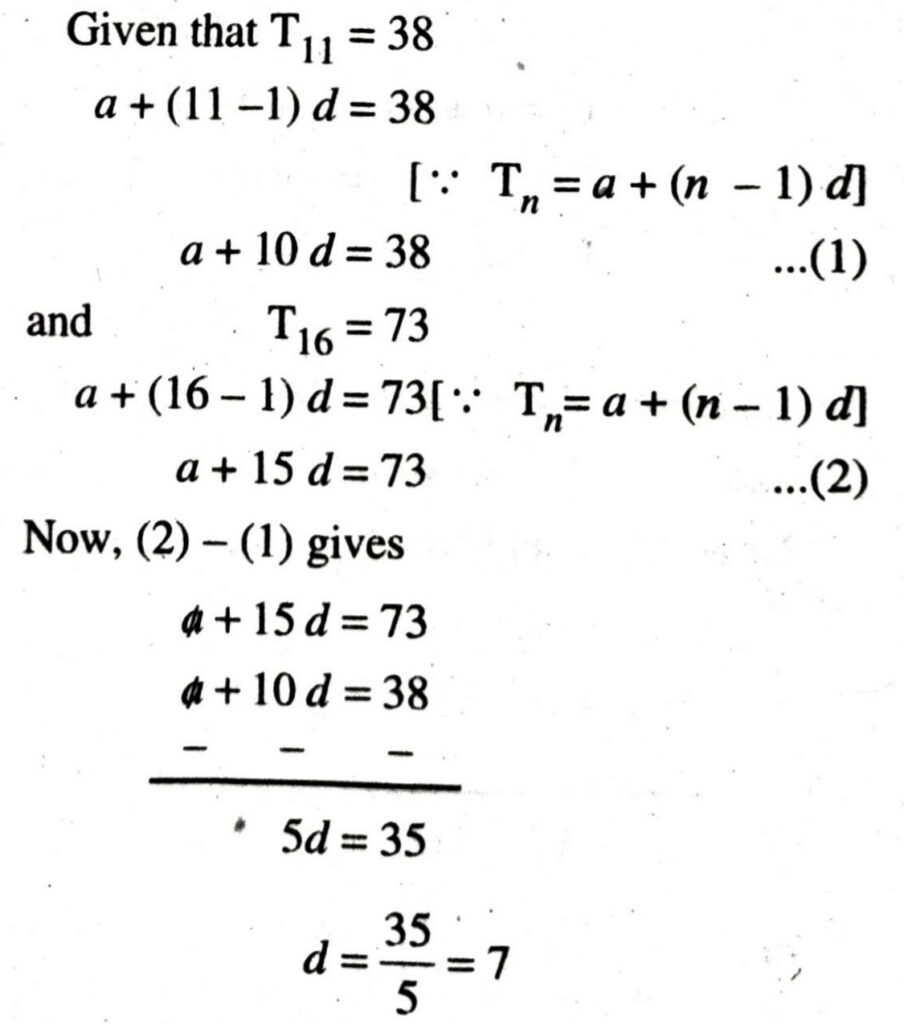
Substitute this value of d in (1), we get
a + 10 (7) = 38
or a + 70 = 38
or a = 38 – 70 = -32
Now, T31 = a + (31-1) d = -32 + 30 (7) = -32 + 210 = 178 Ans.
Q. 8. An A.P. consists of 50 terms of which 3rd term is 12 and the last term is 106. Find the 29th term.
Solution. Let ‘a’ and ‘d be the first term and common difference of given A.P.
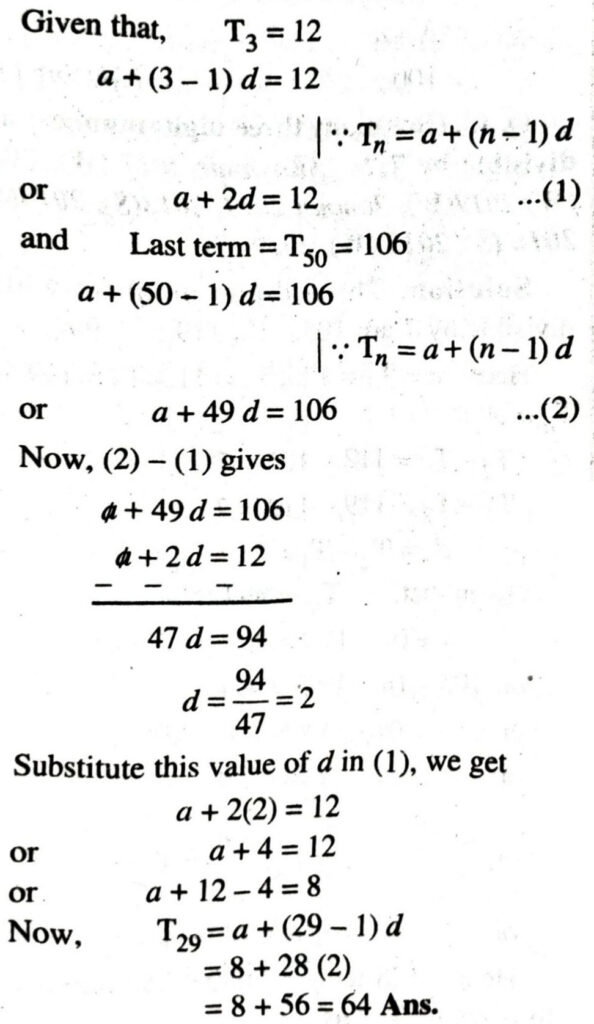
Q. 9. If the 3rd and 9th terms of an A.P. are 4 and – 8 respectively, which term of this A.P. is zero.
Solution. Let ‘a’ and ‘d’ be the first term and common difference of given A.P.
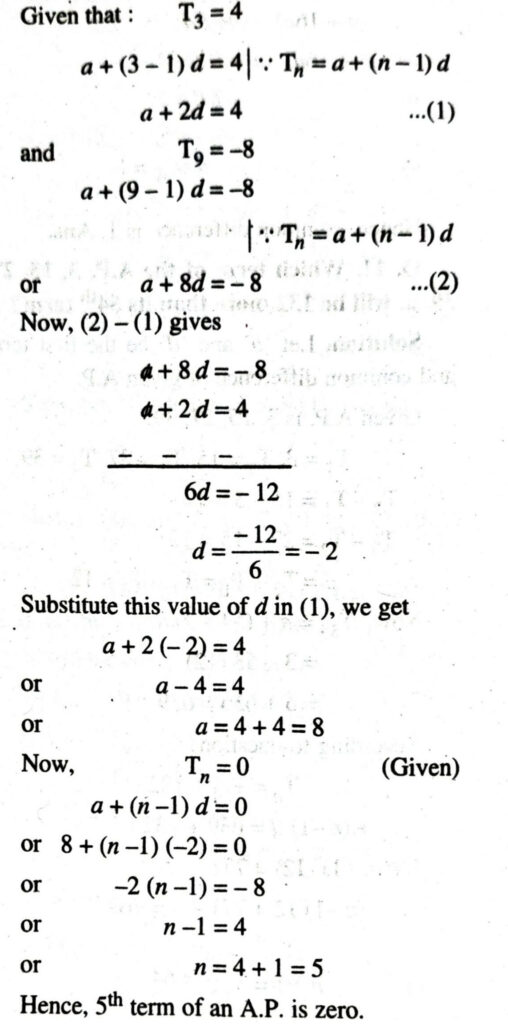
Q. 10. The 17th term of an A.P. exceeds its 10th term by 7. Find the common difference.
Solution. Let ‘a’ and ‘d’ be the first term and common difference of given A.P.
Now, T17 = a + (17-1) d = a + 16d
and T10 = a + (10-1) d = a+ 9d
According to question,
T17 – T10 = 7
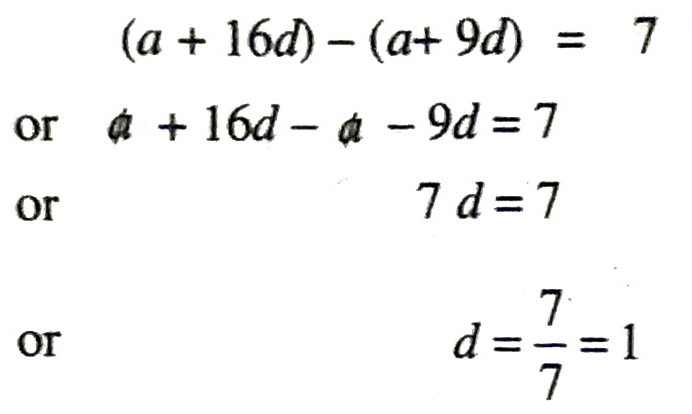
Hence, common difference is 1. Ans.
Q. 11. Which term of the A.P. 3, 15, 27, 39, … will be 132 more than its 54th term?
Solution. Let ‘a’ and ‘d be the first term and common difference of given A.P.
Given A.P. is 3, 15, 27, 39, …
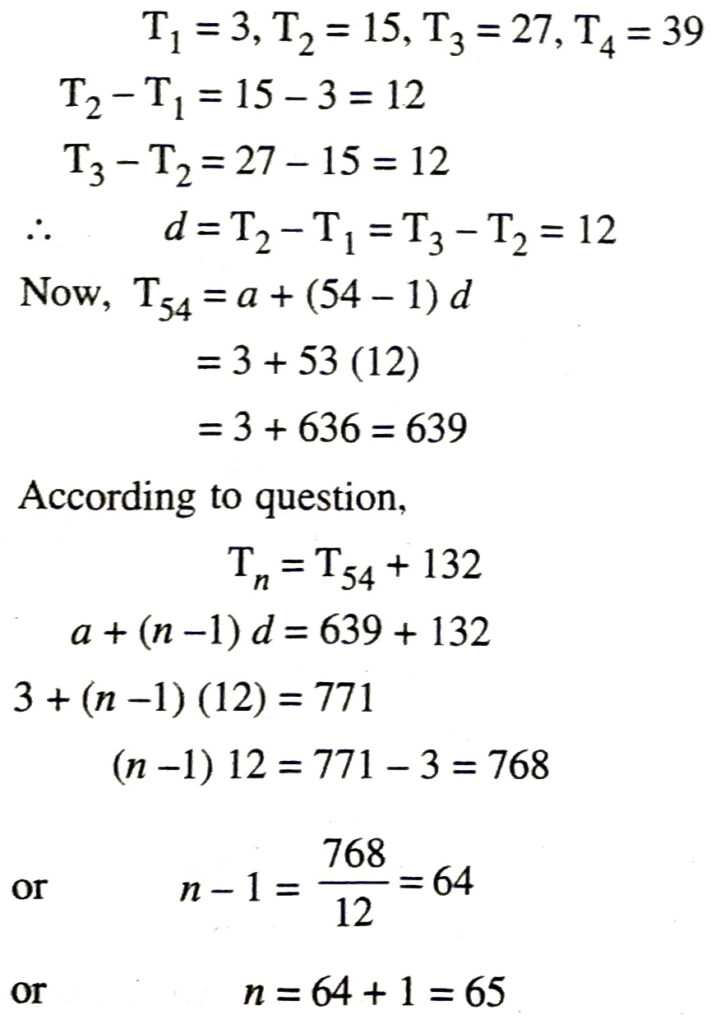
Hence, 65th term of A.P. is 132 more than its 54th term. Ans.
Q. 12. Two A.P.s have the same common difference. The difference between their 100th terms is 100, what is the difference between their 1000th terms?
Solution. Let ‘a’ and ‘d be the first term and common difference of first A.P.
Also, ‘A’ and ‘d’ be the first term and common difference of second A.P.
According to question,
[T100 of second A.P.] – [T100 of first A.P.] = 100
or [A + (100-1)d] – [a + (100-1)d] = 100
or A + 99 d – a – 99 d = 100
or A – a= 100 ….(1)
Now, [T1000 of second A.P.] – [T1000 of first A.P.]
=[A+ (1000-1) d] – (a + (1000-1) d]
= A + 999 d – a – 999 d
= A – a
= 100 [Using (1)]
Q. 13. How many three-digits numbers are divisible by 7?
Solution. Three digits numbers which divisible by 7 are 105, 112, 119,……, 994
Here a = T1 = 105, T2 = 112, T3 = 119 and Tn = 994
T2 – T1 = 112 – 105 = 7
T3 – T1 = 119 – 112 = 7
∴ d = T2 – T1 = T3 – T2 = 7
Given that, Tn = 994
a + (n-1) d = 994
or 105 + (n-1) 7 = 994
or (n-1) 7 = 994 – 105
or (n-1) 7 = 889
or n-1 = 889/7 = 127
or n = 127 + 1 = 128.
Hence, 128 terms of three digit number are divisible by 7. Ans.
Q. 14. How many multiples of 4 lie between 10 and 250?
Solution. Multiples of 4 lie between 10 and 250 are 12, 16, 20, 24,… 248
Here a = T1 = 12, T2 = 16, T3 = 20 and Tn = 248

Hence, there are 60 terms which are multiples of 4 lies between 10 and 250. Ans.
Q. 15. For what value of n, are the nth terms of two A.P.s 63, 65, 67… and 3, 10, 17… equal ?
Solution: Given A.P. is 63, 65, 67,…
Here a = T1 = 63, T2 = 65, T3 = 67
T2 – T1 = 65 – 63 = 2
T3 – T2 = 67 – 65 = 2
∴ d = T2 – T1 = T3 – T2 = 2
and second A.P. is 3, 10, 17, …
Here a = T1 = 3, T2 = 10, T3 = 17
T2 – T1 = 10 – 3 = 7
T3 – T2 = 17 – 10 = 7
According to question,
[nth term of first A.P] = [nth term of second A.P.]
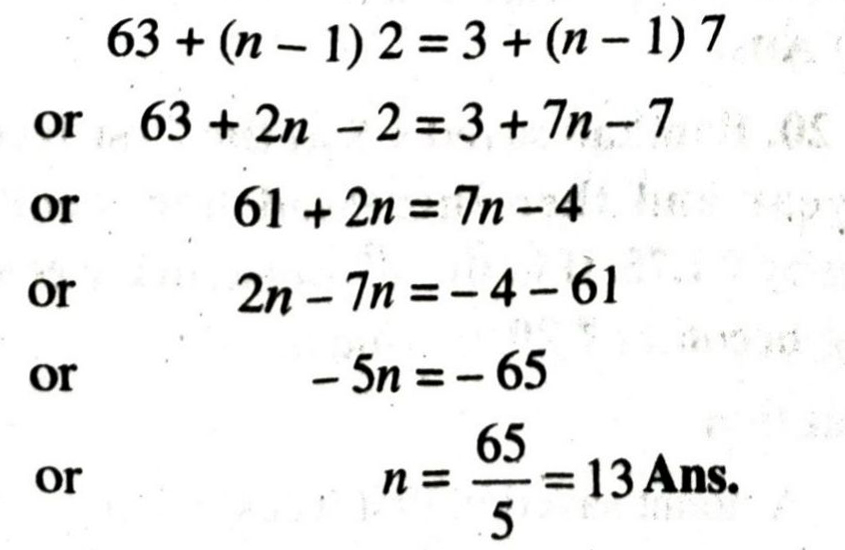
Q. 16. Determine the A.P. whose third term is 16 and 7th term exceeds the 5th term by 12.
Solution. Let ‘a’ and ‘d’ be the first term and common difference of given A.P.
Given that T3 = 16
a +(3-1) d = 16
a + 2d = 16 ..(1)
According to question,
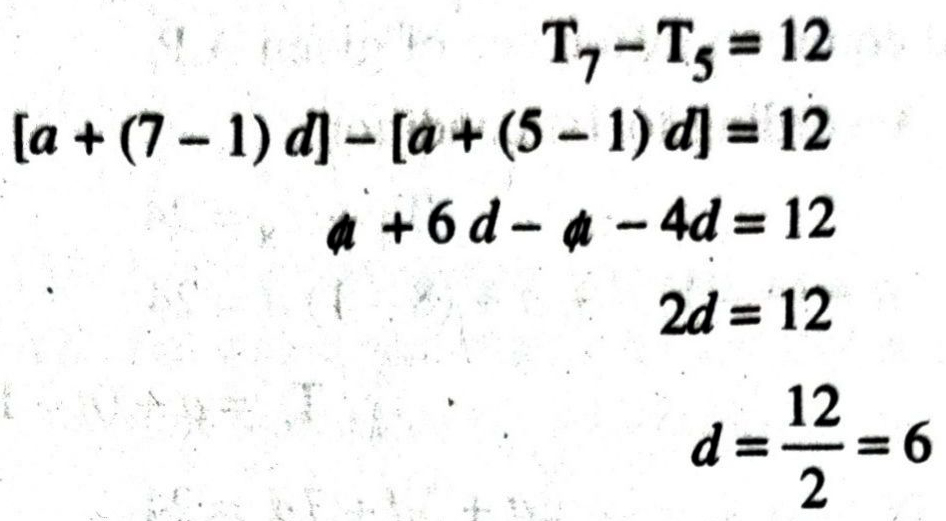
Substitute this value of d in (1), we get
a + 2 (6) = 16
a = 16 – 12 = 4
Hence, given A.P. are 4, 10, 16, 22, 28,… Ans.
Q. 17. Find the 20th term from the last term of the A.P. : 3, 8, 13,…, 253.
Solution. Given A.P. is 3, 8, 13, …, 253
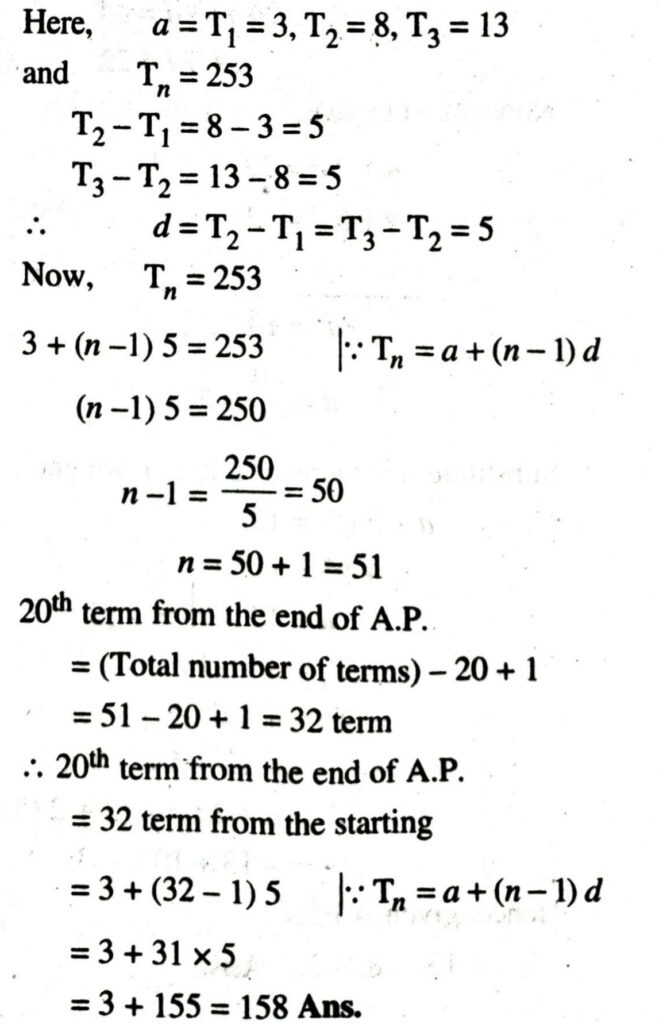
Q. 18. The sum of the 4th and 8th term of an A.P. is 24 and the sum of the 6th and 10th terms is 44. Find the first three terms of the A.P.
Solution. Let ‘a’ and ‘d be the first term and common difference of given A.P.
According to 1st condition,

Q. 19. Subba Rao started work in 1995 at an annual salary of ₹ 5000 and received on increment of ₹ 200 each year. In which year did his income reach ₹ 7000 ?
Solution. Subba Rao’s starting salary = ₹ 5000
Annual increment = ₹ 200
Ler ‘n’ denotes number of years.
∴ first term = a = ₹ 5000
Common difference = d = ₹ 200
and Tn = ₹ 7000
5000 + (n – 1) 200 = 7000
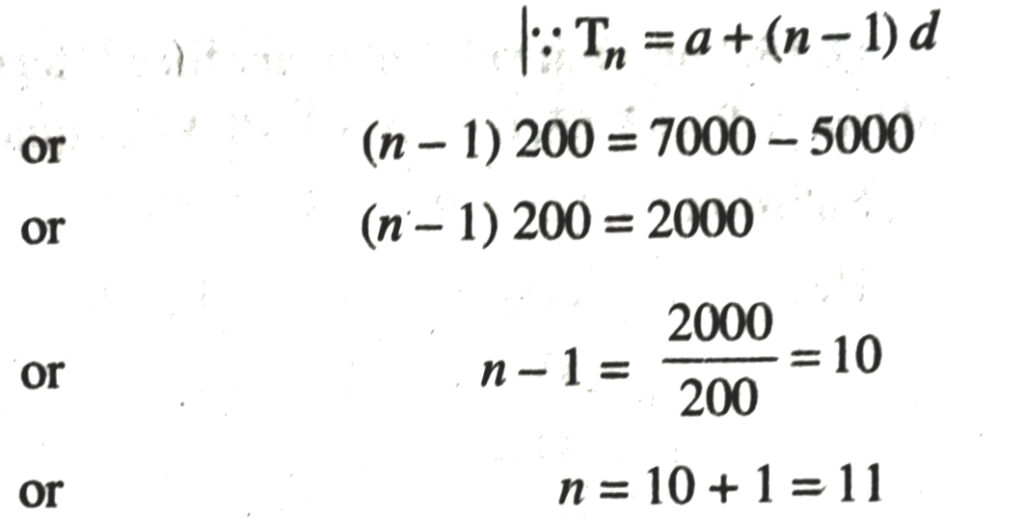
Now, in case of year the sequence are 1995, 1996, 1997, 1998,…
Here a = 1995, d = 1 and n = 11
Let Tn denotes the required year.
∴ Tn 1995 + (11-1) 1
= 1995 + 10
= 2005
Hence, in 2005, Subba Rao’s salary becomes ₹ 7000 Ans.
Q. 20. Ramkali saved ₹ 5 in the first week of a year and then increased her weekly saving by ₹ 1.75. If in the nth week, her weekly saving becomes ₹ 20.75, find n.
Solution.
Amount saved in first week = ₹ 5
Increment in saving every week = ₹ 1.75
It is clear that, it form an A.P. whose terms are
T1 = 5, d = 1.75
∴ T2 = 5 + 1.75 = 6.75
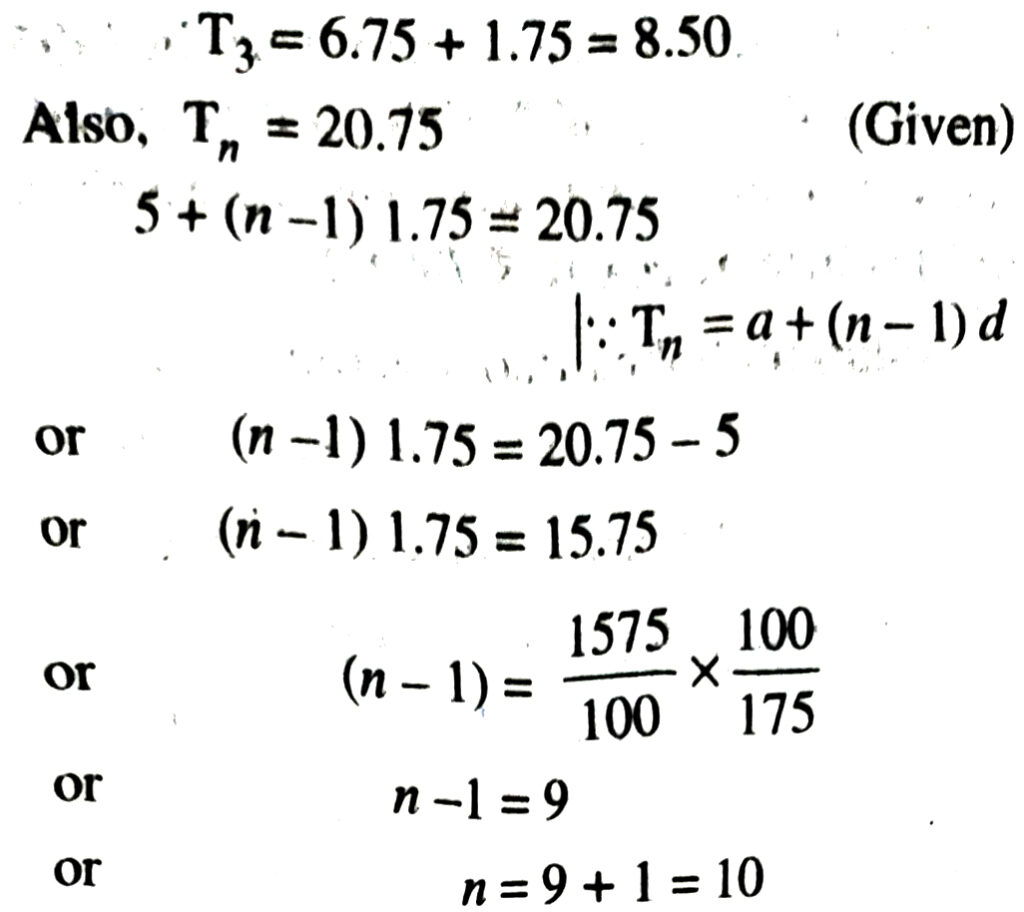
Hence, in 10th week, Ramkali’s saving becomes ₹ 20.75 Ans.
TEXT BOOK EXERCISE 5.3
Q. 1. Find the sum of the following A.P.S :
(i) 2, 7, 12, to 10 terms.
(ii) -37, 33, -29,… to 12 terms.
(iii) 0.6, 1.7, 2.8, ……. to 100 terms.
(iv) 1/15, 1/12, 1/10, ……… tp 11 terms.
Solution. (i) Given A.P. is
2, 7, 12,…
Here a = 2, d = 7 -2 = 5 and n = 10

(iii) Given A.P. is 0.6, 1.7, 2.8,….
Here a = 0.6, d 1.7 – 0.6 = 1.1 and n = 100
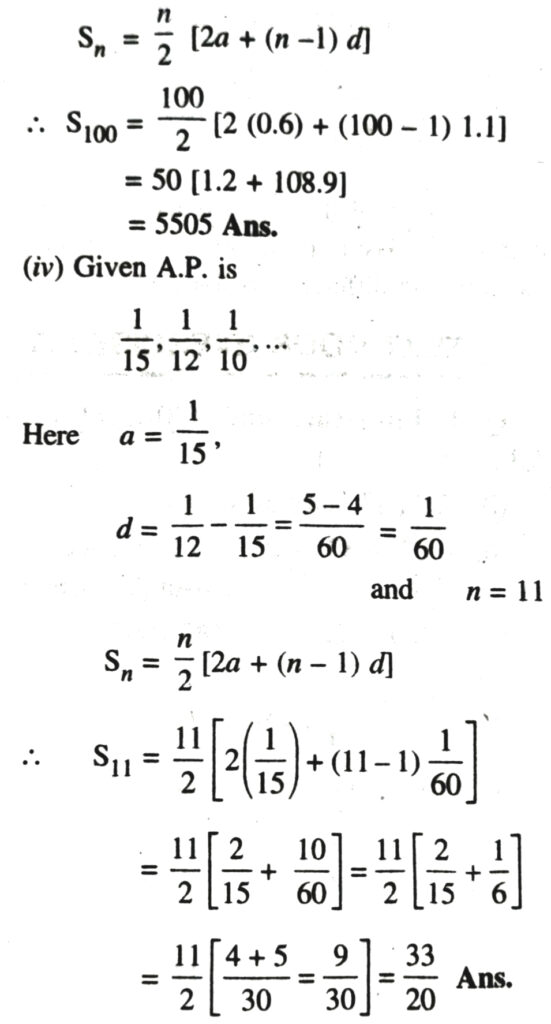
Q. 2. Find the sums given below :

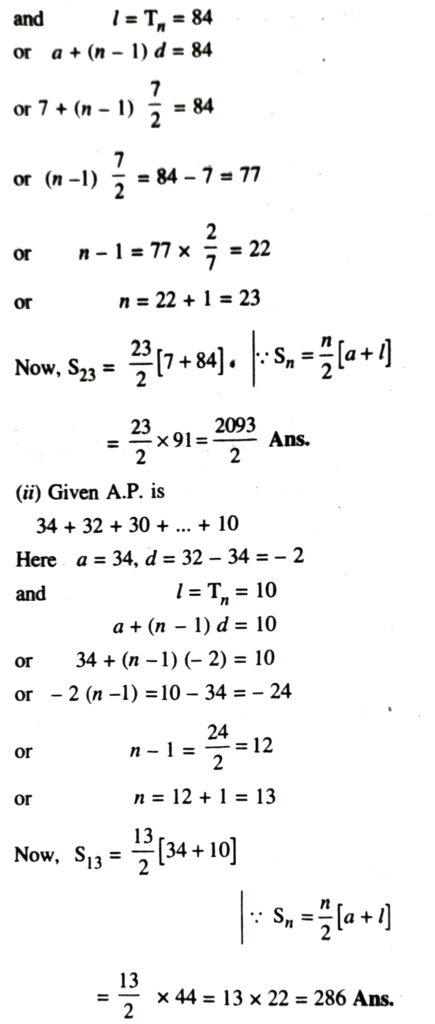
(iii) Given A.P. is
– 5 + (-8) + (-11) + … + (-230)
Here a = -5, d = -8 + 5 = -3
and l = Tn = -230
a + (n-1) d = -230
or -5+ (n − 1) (-3) = -230
or -3 (n-1) = -230 + 5 = 225

Q. 3. In an A.P. :
(i) given a = 5, d = 3, an = 50, find n and Sn.
(ii) given a = 7, a13 = 35, find d and S13.
(iii) given a12 = 37, d = 3. find a and S12.
(iv) given a3 = 15, S10 = 125, find d and a10.
(v) given d = 5, S9 = 75, find a and a9.
(vi) given a = 2, d = 8, Sn = 90, find n and an.
(vii) given a = 8, an = 62. Sn = 210, find n and d.
(viii) given an = 4, d = 2, Sn = − 14, find n and a.
(ix) given a = 3, n = 8, S = 192, find d.
(x) given l = 28, S = 144, and there are total 9 terms. Find a.
Solution. (i) Given a = 5, d = 3, an = 50
∵ an = 50
a + (n-1) d = 50
or 5 + (n-1) 3 = 50
or 3 (n-1) = 50 – 5 = 45
or n-1 = 45/3 = 15
or n = 15 + 1 = 16

(ii) Given a = 7, a13 = 35
∵ a13 = 35
a + (n-1) d = 35
or 7 + (13-1) d = 35
or 12d =35 – 7 = 28
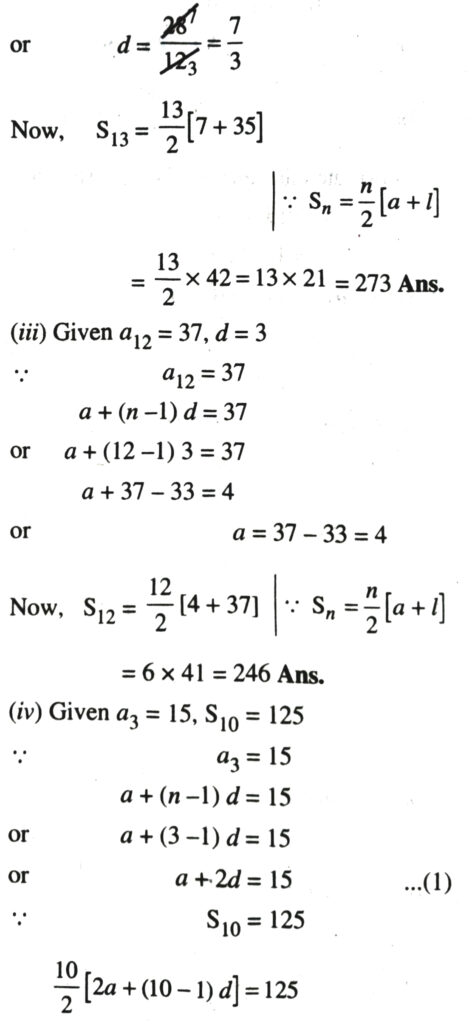
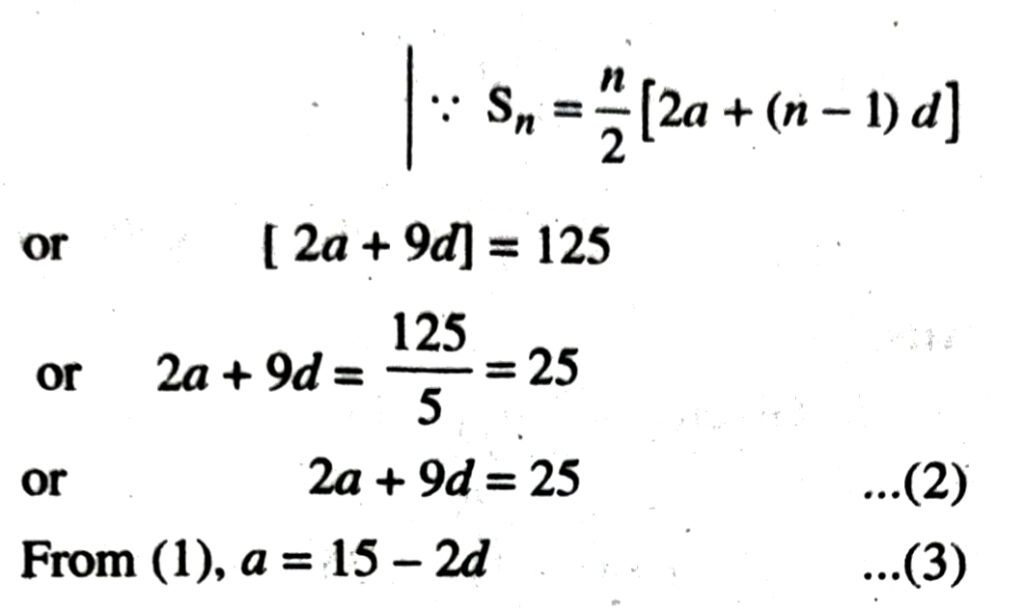
Substitute this value of (a) in (2), we get
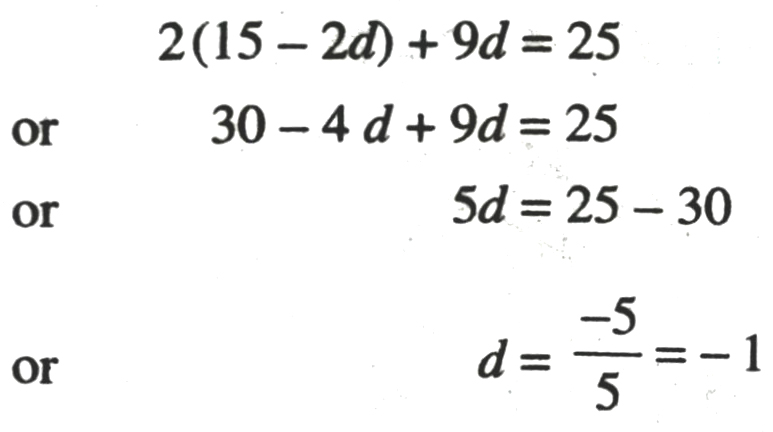
Substitute this value of d in (3), we get
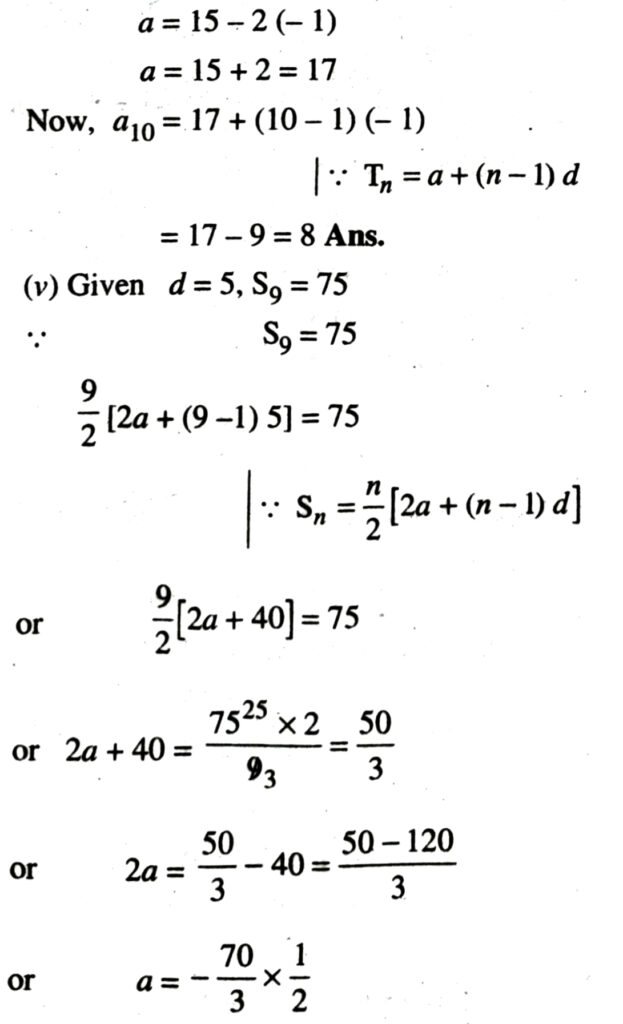

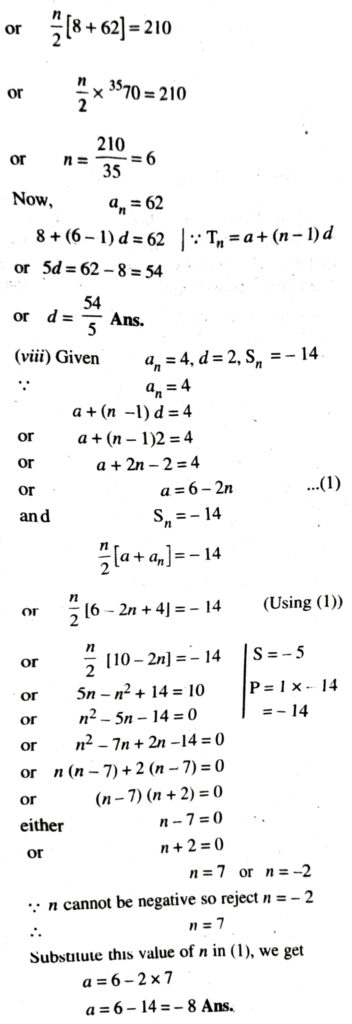
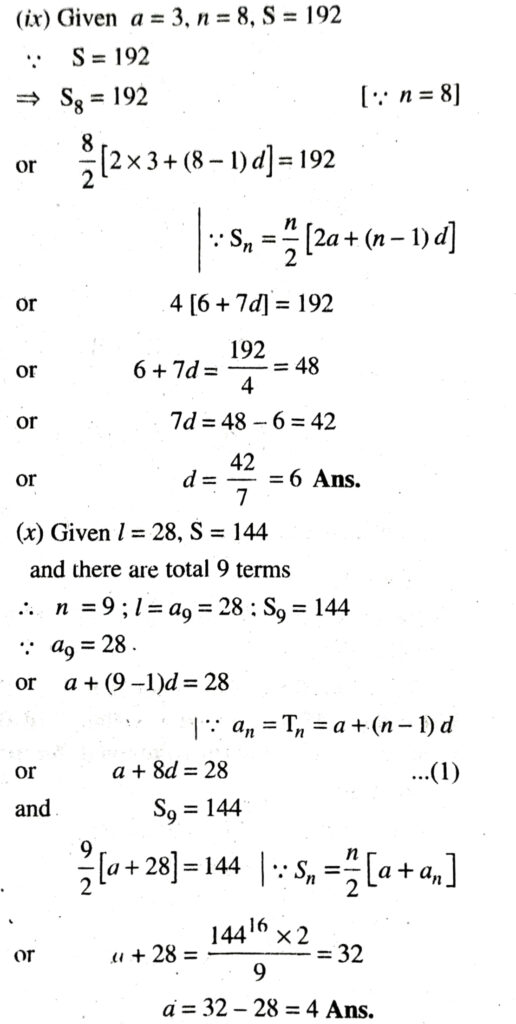
Q. 4. How many terms to the A.P. : 9, 17, 25. must be taken to give a sum of 636?
Solution. Given A.P. is 9, 17, 25, …
Here a = 9, d = 17 – 9 = 8
But Sn = 636
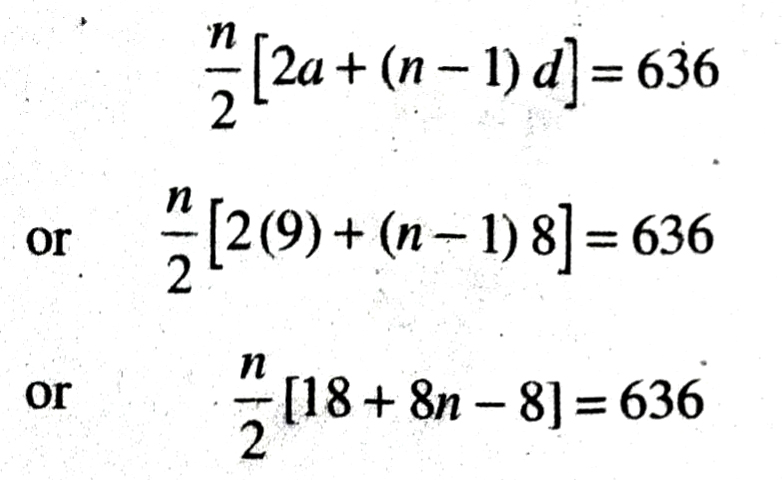
or n [4n + 5] = 636
or 4n² + 5n – 636 = 0
a = 4, b = 5, c = – 636
D = (5)2 – 4 × 4 × (-636)
= 25 + 10176
= 10201
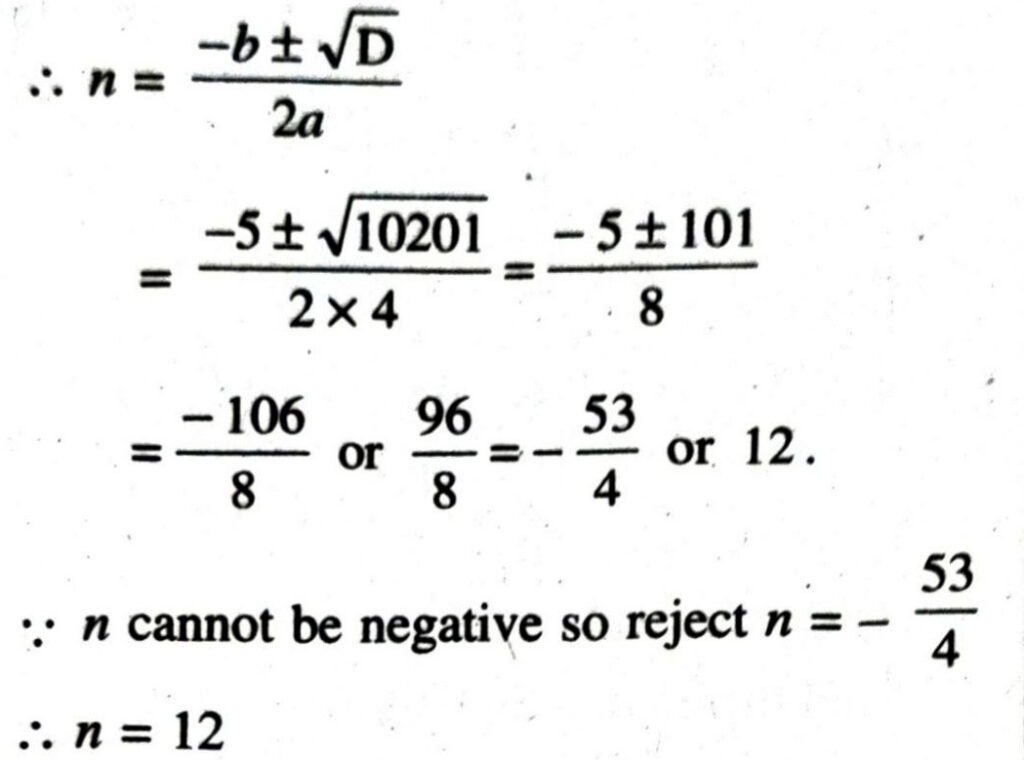
Hence, sum of 12 terms of given A.P. has sum 636 Ans.
Q. 5. The first term of an A.P. is 5, the last term is 45 and the sum is 400. Find the number of terms and the common difference.
Solution.
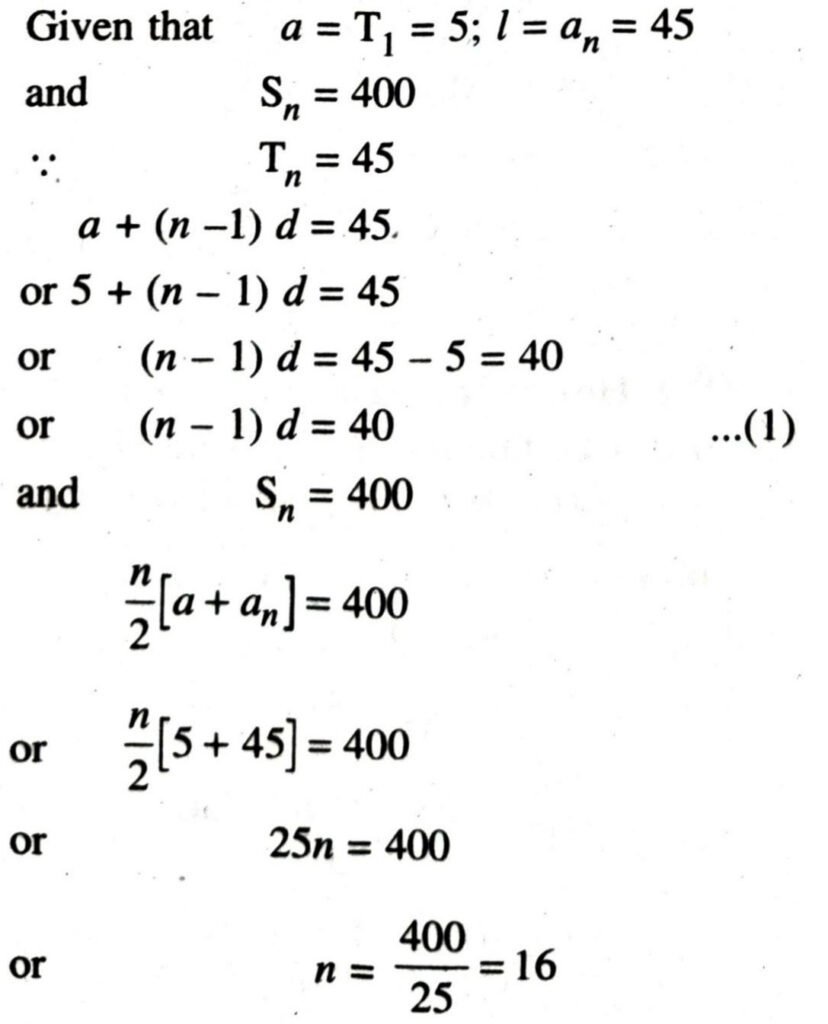
Substitute this value of n in (1), we get
(16-1) d = 40
or 15d = 40
or d = 40/15 = 8/3
Hence, n = 16 and d = 8/3 Ans.
Q. 6. The first and last terms of an A.P. are 17 and 350 respectively. If the common difference is 9, how many terms are there and what is their sum ?
Solution. Given that a = T1 = 17; l = an = 350
and d = 9
∵ l = an = 350
a + (n-1) d = 350
17 + (n -1) 9 = 350
or 9 (n-1) = 350 – 17 = 333

Hence, sum of 38 terms of given A.P. are 6973. Ans.
Q. 7. Find the sum of first 22 terms of an A.P. in which d= 7 and 22nd term is 149.
Solution. Given that d = 7; T22 = 149 and n = 22
∵ T22 = 149
a + (n-1) d = 149
or a +(22-1) 7 = 149
or a + 147 = 149
or a = 149 – 147 = 2

= 11 x 151 = 1661
Hence, sum of first 22 terms of given A.P. is 1661. Ans.
Q. 8. Find the sum of first 51 terms of an A.P. whose second and third terms are 14 and 18 respectively.
Solution. Let ‘a’ and ‘d be first term and common difference
Given that T2 = 14; T3 = 18 and n = 51
∵ T2 = 14
a + (n −1) d = 14
a +(2 – 1) d = 14
or a + d = 14
a = 14 – d …(1)
and T3 = 18 (Given)
a + (n −1) d = 18
a + (3 − 1) d = 18
or a + 2d = 18
or 14 – d + 2d = 18
or d = 18 -14 = 4
or d = 4
Substitute this value of d in (1), we get
a = 14 – 4 = 10

Hence, sum of first 51 terms of given A.P. is 5610. Ans.
Q. 9. If the sum of first 7 terms of an A.P. is 49 and that of 17 terms is 289, find the sum of first n terms.
Solution. Let ‘a’ and ‘d be the first term and common difference of given A.P.
According to 1st condition,

According to 2nd condition,
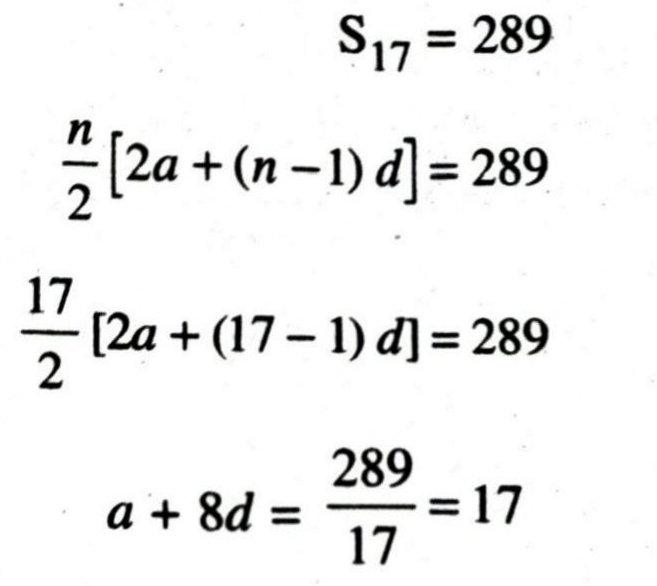
Substitute the value of a from (1), we get
7 – 3d + 8d = 17
5d = 17 – 7 = 10
d = 10/5 = 2
Substitute this value of d in (1), we get
a = 7 – 3 x 2
a = 7 – 6 = 1
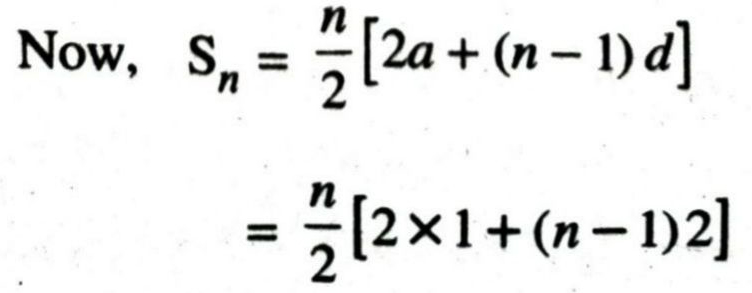

Hence, sum of first n terms of given A.P. is n². Ans.
Q. 10. Show that a1, a1, ….. an,.. form an A.P. where an, is defined as below.
(i) an = 3 + 4n (ii) an = 9 – 5n
Also find the sum of the first 15 terms in each case.
Solution. (i) Given that an 3 + 4n …(1)
Putting the different values of n in (1), we get
a1 = 3 + 4 (1) = 7 ;
a2 = 3 + 4 (2) = 11 ;
a3 = 3 + 4 (3) = 15, ……
Now, a2 – a1 = 11 – 7
and a3 – a2 = 15 – 11 = 4
∵ a2 – a1 = 11 – 7 = 4
and a3 – a2 = 4 = d (say)
∴ given sequence form an A.P.
Here a = 7, d = 4 and n = 15

= 15 x 35 = 525 Ans.
(ii) Given that an = 9 – 5n ….(1)
Putting the different values of n is (1), we get
a1 = 9 – 5 (1) = 4 ;
a2 = 9 – 5 (2) = -1 ;
a3 = 9 – 5 (3) = -6
Now, a2 – a1 = -1 -4 = -5
and a3 – a2 = -6 + 1 = -5
∵ a2 – a1 = a3 – a2 = -5 = d (say)
∴ given sequence form an A.P.
Here a = 4, d = -5 and n = 15

= – 465 Ans.
Q. 11. If the sum of the first n terms of an A.P. is 4n – n², what is the first term (that is S1)? What is the sum of first two terms? What is the second term ? Similarly, find the 3rd, the 10th and the nth terms.
Solution. Given that, s… of n terms of an A.P. are
Sn = 4n – n² …(1)
Putting n = 1 in (1), we get
S1 = 4 (1) – (1)² = 4 − 1
S1 = 3
∴ a = T1 = S1 = 3
Putting n = 2, in (1), we get
S2 = 4 (2) – (2)² = 8 – 4
S2 = 4
or T1 + T2 = 4
or T3 + T2 = 4
or T2 = 4 – 3 = 1
Putting n = 3 in (1), we get
S3 = 4 (3) – (3)² = 12 – 9
S3 = 3
or S2 + T3 = 3
or 4 + T3 = 3
or T3 = 3 – 4 = – 1
Now, d = T2 = T1
= 1 – 3 = – 2
T10 = a + (n-1) d
= 3 + (10-1) (-2)
T10 = 3 – 18 = – 15
and T1 = a + (n-1) d
= 3 + (n – 1) (-2)
= 3 – 2n + 2
Tn = 5 – 2n
Q. 12. Find the sum of the first 40 positive integers divisible by 6.
Solution. Positive integers divisible by 6 are
6, 12, 18, 24, 30, 36, 42, …
Here a = T1 = 6, T2 = 12, T3 = 18, T4 = 24
T2 – T1 = 12 – 6 = 6
T3 – T2 = 18 – 12 = 6
T4 – T3 = 24 – 18 = 6
∵ T2 – T1 = T1 – T2
= T4 – T3 = 6 = d (say)
Using formula, Sn = n/2 [2a + (n − 1)d]
S40 = 40/2 [2(6) + (40-1) 6]
= 20 [12 + 234]
= 20 (246) = 4920
Hence, sum of first 40 positive integers divisible by 6 is 4920. Ans.
Q. 13. Find the sum of first 15 multiples of 8.
Solution. Multiples of 8 are
8, 16, 24, 32. 40, 48, ..
Here a = T1 = 8; T2 = 16; T3 = 24; T4 = 32
T2 – T1 = 16 – 8 = 8
T3 – T2 = 24 – 16 = 8
∵ T2 – T1 = T3 – T2 = 8 = d (say)
Using formula, Sn = n/2[2a + (n 1) d]
S15 = 15/2 [2(8) + (15-1) 8]
= 15/2 [16 + 112]
= 15/2 × 128 = 960
Hence, sum of first 15 multiples of 8 is 960. Ans.
Q. 14. Find the sum of the odd numbers between 0 and 50.
Solution. Odd numbers between 0 and 50 are 1, 3, 5, 7, 9, ….. 49
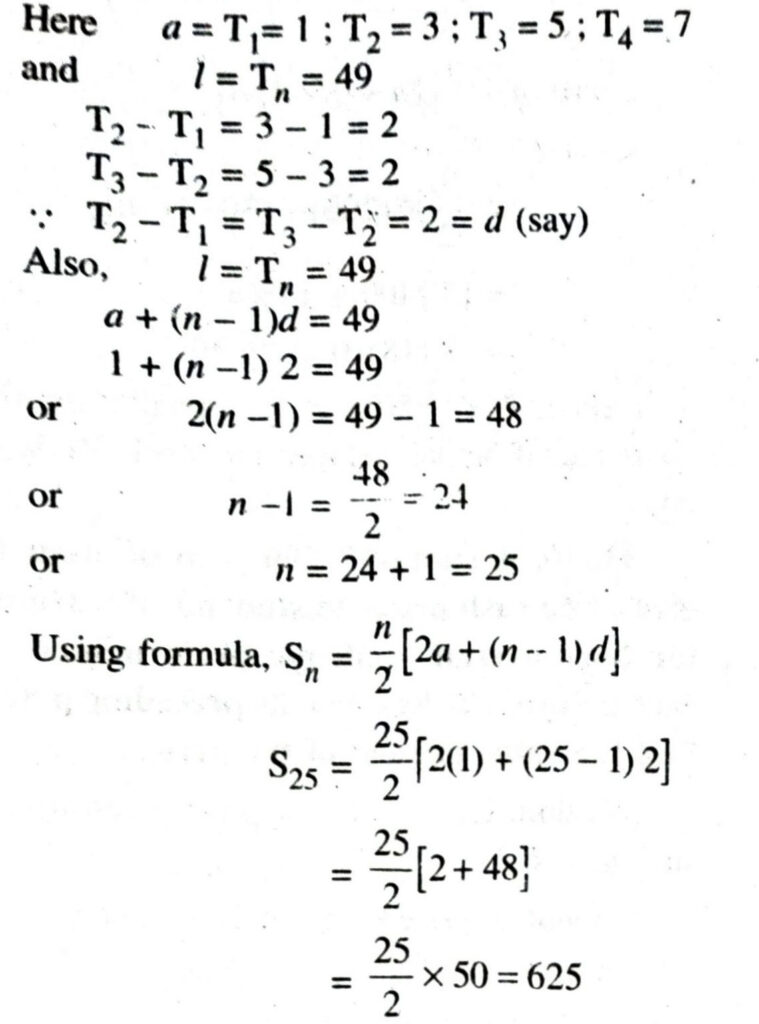
Hence, sum of the odd numbers between 0 and 50 are 625 Ans.
Q. 15. A contract on construction job specifies a penalty for delay of completion beyond a certain date as follows: ₹ 200 for the first day, ₹ 250 for the second day, ₹ 300 for the third day, etc., the penalty for each succeeding day being ₹ 50 more than for the preceding day. How much money the contractor has to pay as penalty, if he has delayed the work by 30 days ?
Solution. Penalty (cost) for delay of one two, third day are
₹ 200, ₹ 250, ₹ 300
Now, penalty increase with next day with a difference of ₹ 50.
∴ Required A.P. are
₹ 200, ₹ 250, ₹ 300, ₹ 350, …
Here a = T1 = 200;
d = ₹ 50 and n = 30
Amount of penalty gives after 30 days
= S30
= n/2 [2a + (n − 1) d]
= 30/2 [2(200) + (30 – 1) 50]
= 15 [400 + 1450]
= 15 (1850) = 27750
Hence, ₹ 27,750 pay as penalty by the contractor if he has delayed the work 30 days. Ans.
Q. 16. A sum of ₹ 700 is to be used to give seven cash prizes to students of a school for their overall academic performance. If each prize is ₹ 20 less than its preceding prize, find the value of each of the prizes.
Solution. Let amount of prize given to 1st student = ₹ x
Amount of prize given to 2nd student
= ₹ (x – 20)
Amount of prize given to 3rd student
= ₹ [x – 20 – 20]
= ₹ (x – 40)
and so on.
∴ Required sequence are
₹ x, ₹ (x – 20), ₹ (x − 40), …
which form on A.P. with
a = ₹ x, d = – 20 and n = 7
Using formula, Sn = n/2 [2a + (n − 1) d]
S7 = 7/2 [2(x) + (7 − 1) (- 20)]
S7 = 7/2 [2x – 120] = 7 (x-60)
= 7 (x – 60)
According to question,
7 (x – 60) = 700
x – 60 = 700/7 = 100
x = 100 + 60
x = 160
Hence, 7 prizes are ₹ 160, ₹ 140, ₹ 120, ₹ 100, ₹ 80, ₹ 60, ₹ 40 Ans.
Q. 17. In a school, student thought of planting trees in and around the school to reduce air pollution. It was decided that number of trees, that each section of each class will plant, will be the same as the class, in which they are studying, e.g. a section of Class I will plant 1 tree, a section of Class II will plant 2 trees and so on till Class XII. There are three sections of each class. How many trees will be planted by the students ?
Solution. Number of trees planted by three sections of class I = 3 × 1 = 3
Number of trees planted by three sections of class II = 3 × 2 = 6
Number of trees planted by three sections of class III = 3 × 3 = 9
……………………………………………
……………………………………………
……………………………………………
Number of trees planted by three sections of class XII = 3 × 12 = 36
∴ Required A.P. are
3, 6, 9,…, 36
Here a = T1 = 3; T2 = 6; T3 = 9
and l = Tn = 36; n = 12
d = T2 – T1 = 6 – 3 = 3
Total number of trees planted by students
= S12
= n/2 [a + l]
= 12/2 [3 + 36]
= 6 × 39 = 234
Hence, 234 trees will be planted by students to reduce air pollution. Ans.
Q. 18. A spiral is made up of successive semicircles, with centres alternately at A and B, starting with centre at A, of radii 0.5 cm, 1.0 cm, 1.5 cm, 2.0 cm, ….. as shown in Fig. What is the total length of such a spiral made up of thirteen consecutive semicircles ? (Tak π = 22/7)
[Hint: Length of successive semicircles is l1, l2, l3, l4, …… with centres at A, B, A, B, … , respectively.]
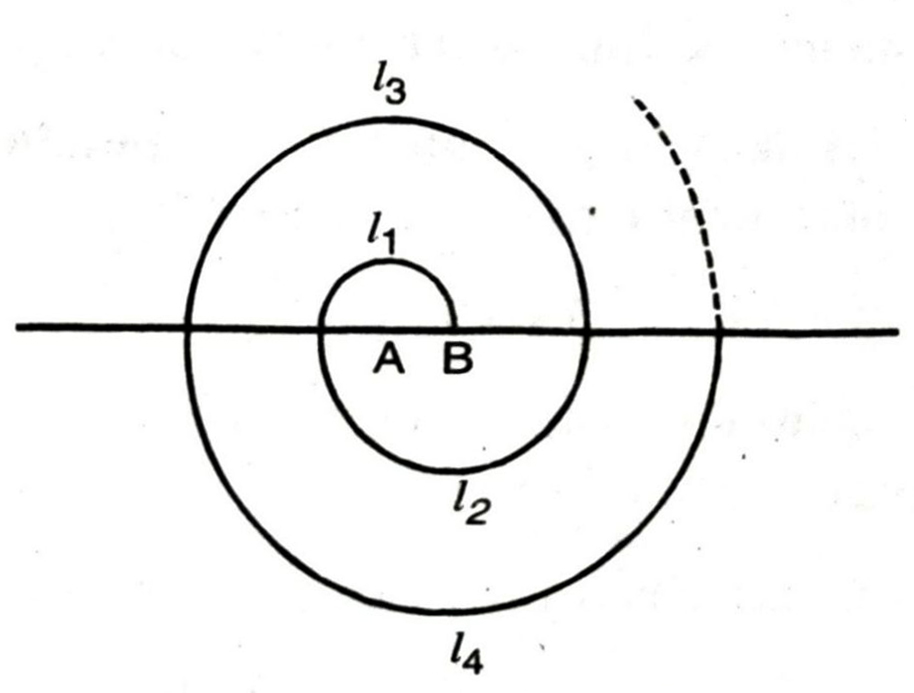
Solution. Let l1 = length of first semi circle
= πr1 = π(0.5) = π/2
l2 = length of second semi circle
= πr2 = π(1) = π
l3 = length of third semi circle
= πr3= π (1.5) = 3π/2
and l4 = length of fourth semi circle
= πr4= π(2) = 2π and so on
∵ length of each successive semicircle form an A.P.
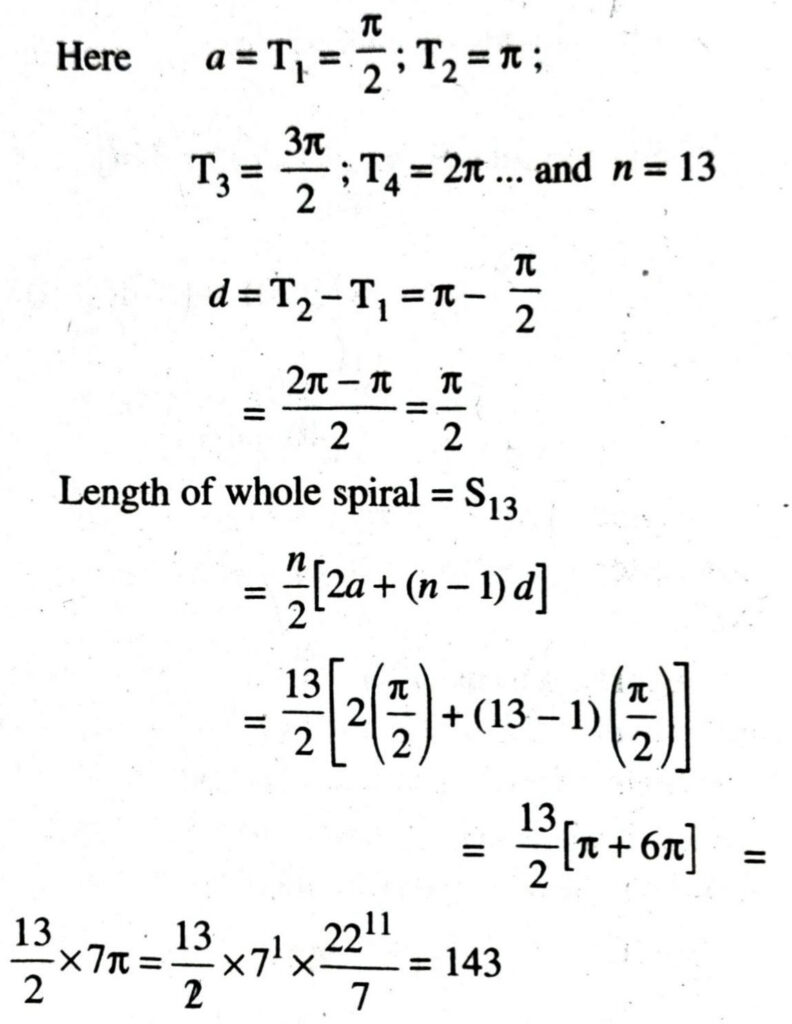
Hence, total length of a spiral made up of thirteen consecutive semicircles is 143 cm. Ans.
Q. 19. 200 logs are stacked in the following manner: 20 logs in the bottom row, 19 in the next row, 18 in the row next to it and so on (see Fig). In how many rows are the 200 logs placed and how many logs are in the top row ?

Solution.
Number of logs in the bottom (1st row) = 20
Number of logs in the 2nd row = 19
Number of logs in the 3rd row= 18 an so on.
∴ Number of logs in the each steps form an A.P.
Here a = T1 = 20; T2 = 19; T3 = 18..
d = T2 – T1 = 19 – 20 = – 1
Let Sn denotes the number logs.

According to question,
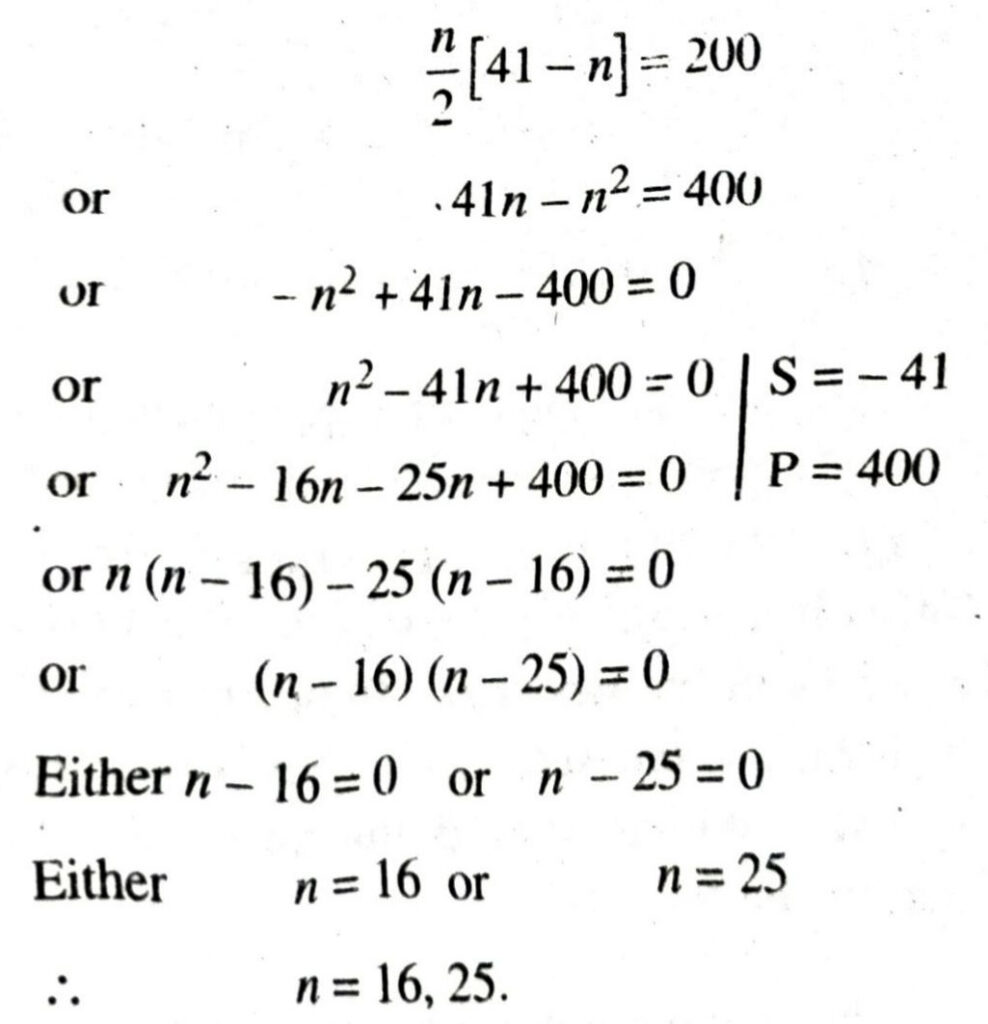
Case I. When n = 25
T25 = a + (n-1) d
= 20 + (25-1) (-1)
= 20 – 24 = – 4; which is impossible
∴ n = 25 rejected.
Case II. When n = 16
T16 = a + (n-1) d
= 20 + (16-1) (-1)
= 20 – 15 = 5
Hence, there are 16 row and 5 logs are in the top row. Ans.
Q. 20. In a potato race a bucket is placed at the starting point, which is 5 m from the first potato, and the other potatoes are placed 3 m apart in a straight line. There are ten potatoes in the line (see Fig.)
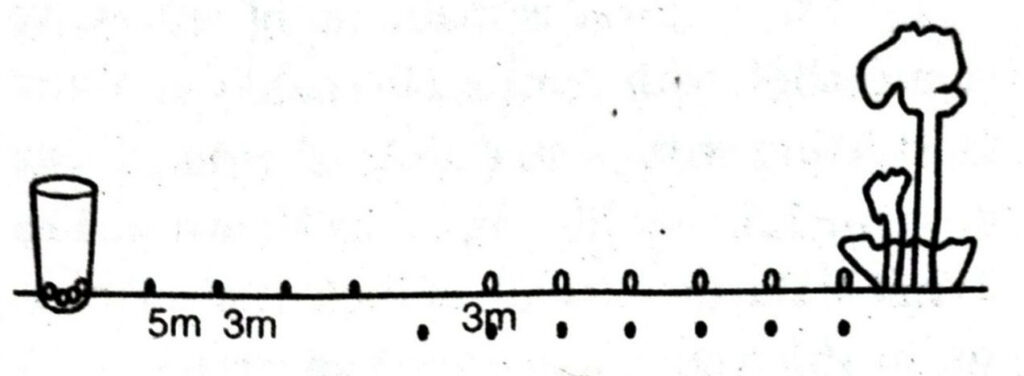
A competitor starts from the bucket, picks up the nearest potato, runs back with it, drops it in the bucket, runs back to pick up the next potato, runs to the bucket to drop it in, and the continues in the same way until all the potatoes are in the bucket. What is the total distance the competitor has to run ?
[Hint: To pick up the first potato and second potato, the distance run is 2 x 5 + 2 x (5 + 3) m]
Solution. Distance covered to pick up the 1st potato = 2(5) m = 10 m
Distance between successive potato = 3 m
∴ distance covered to pick up the 2nd potato = 2 (5 + 3) m = 16 m
Distance covered to pick up the 3rd potato = 2 (5 + 3 + 3) m = 22 m
and this process go on. It is clear that this situation becomes an A.P. as
10 m, 16 m, 22 m, 28 m, …
Here a = T1 = 10; T2 = 16; T3 = 22, …
d = T2 – T1 = 16 – 10 = 6 and n = 10
∴ Total distance the competitor has to run
= S10 = n/2 [2a + (n-1)d]
= 10/2 [2(10) + (10-1)6]
= 5 [20 + 54]
= 5 x 74 = 370
Hence, 370 m is the total distance run by a competitor. Ans.
TEXT BOOK EXERCISE 5.4 (OPTIONAL)
Q. 1. Which term of the A.P. 121, 117, 113, …. is its first negative term ?
Solution. Given A.P. is 121, 117, 113,…
Here a = T₁ = 121 ; T₂ = 117 ; T3 = 113
d = T₂ – T₁ = 117 – 121 = – 4
Using formula, Tn = a + (n-1) d
Tn = 121 + (n − 1) (-4)
= 121 – 4n + 4
= 125 – 4n.
According to question :-
Tn < 0
or 125 – 4n < 0
or 125 < 4n
or 4n > 125.
or n > 125/4
or n > 31 1/4.
But n must be integer, for first negative term.
∴ n = 32.
Hence, 32nd term be the first negative term of given A.P. Ans.
Q. 2. The sum of the third and the seventh term of an A.P. is 6 and their product is 8. Find the sum of first sixteen terms of an A.P.
Solution. Let ‘a’ and ‘d’ be the first term and common difference of given A.P.
According to 1st condition

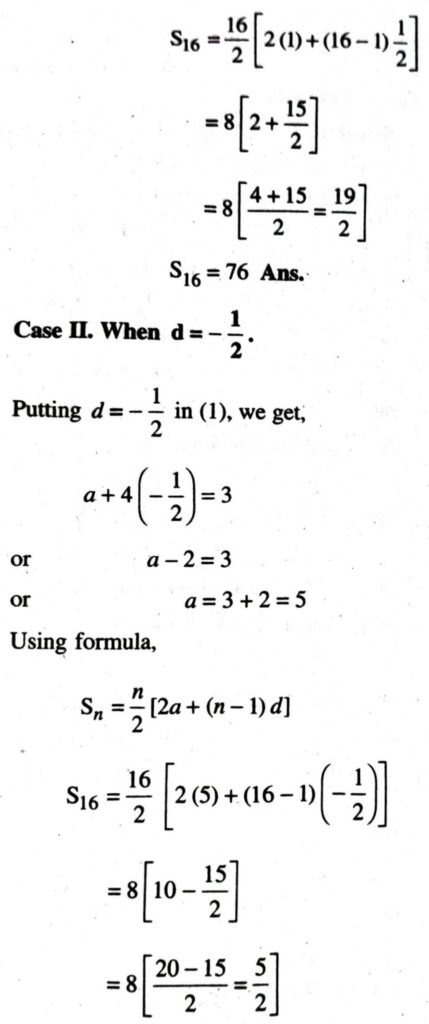
S16 = 20 Ans.
Q. 3. A ladder has rungs 25 cm apart (see fig.) The rungs decrease uniformly in length from 45 cm at the bottom to 25 cm at the top. If the top and bottom rungs are  m apart, what is the length of the wood required for the rungs ?
m apart, what is the length of the wood required for the rungs ?

[Hint Number of rungs = 250/25]
Solution. Total length of rungs

Length of each rung
= 25 cm
∴ Number of rungs
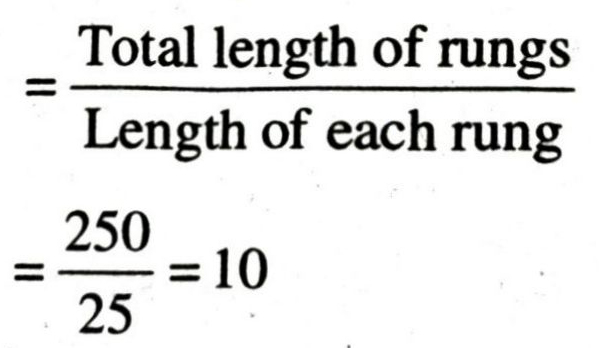
Length of first rung = 45 cm
Here a = 45 ; l= 25; n = 10
Length of the wood for rungs
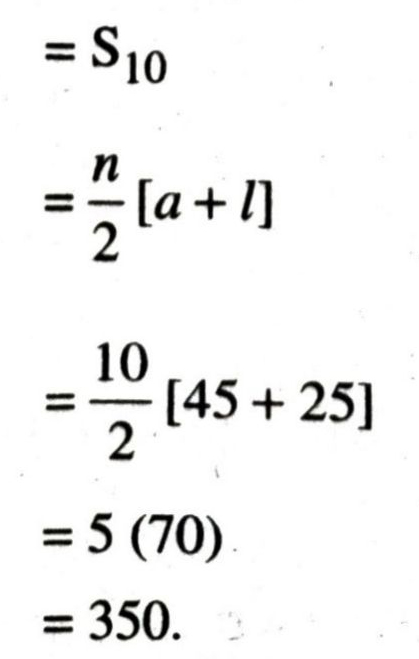
Hence, length of the wood for rungs has 350cm Ans.
Q. 4. The houses of a row are numbered consecutively from 1 to 49. Show that there is a value of x such that the sum of the numbers of the houses preceding the house numbered x is equal to the sum of the numbers of the houses following it and find this value of x.
[Hint: Sx-1 = S49 – Sx]
Solution. Let ‘x’ denotes the number of any house.
Here a = T₁ = 1; d = 1
According to question,
Sx-1 = S49 – Sx
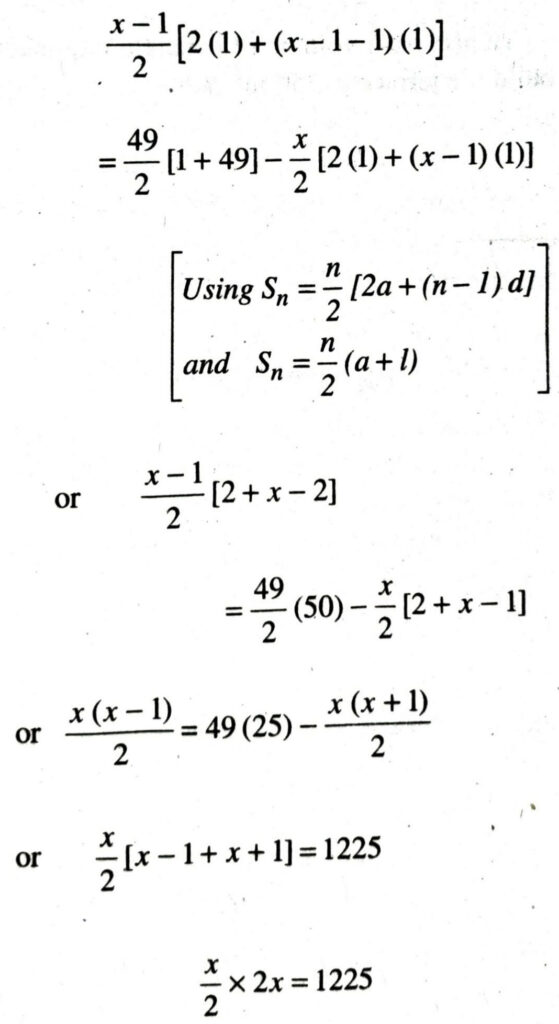
or x² = 1225
or x = 35 Ans.
Q. 5. A small terrace at a football ground comprises of 15 step each of which is 50m long and built of solid concrete.
Each step has a rise of 1/4 m and a tread of 1/2 m (see fig.) Calculate the total volume of concrete required to build the terrace.
[Hint. Volume of concrete required to build the first step 1/4 x 1/2 x 50 m³]

Solution. Volume of concrete required to build the first step
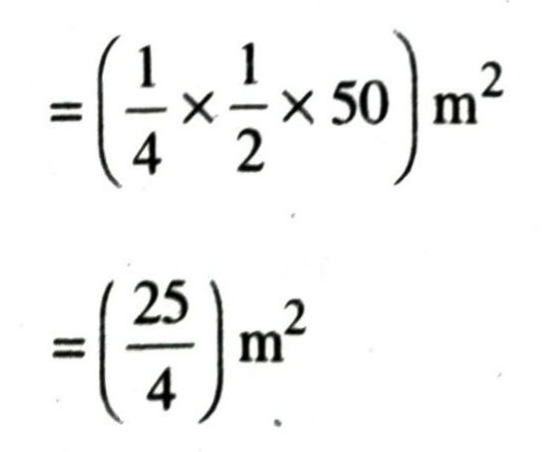
Volume of concrete required to build the second step

Volume of concrete required to build the third step
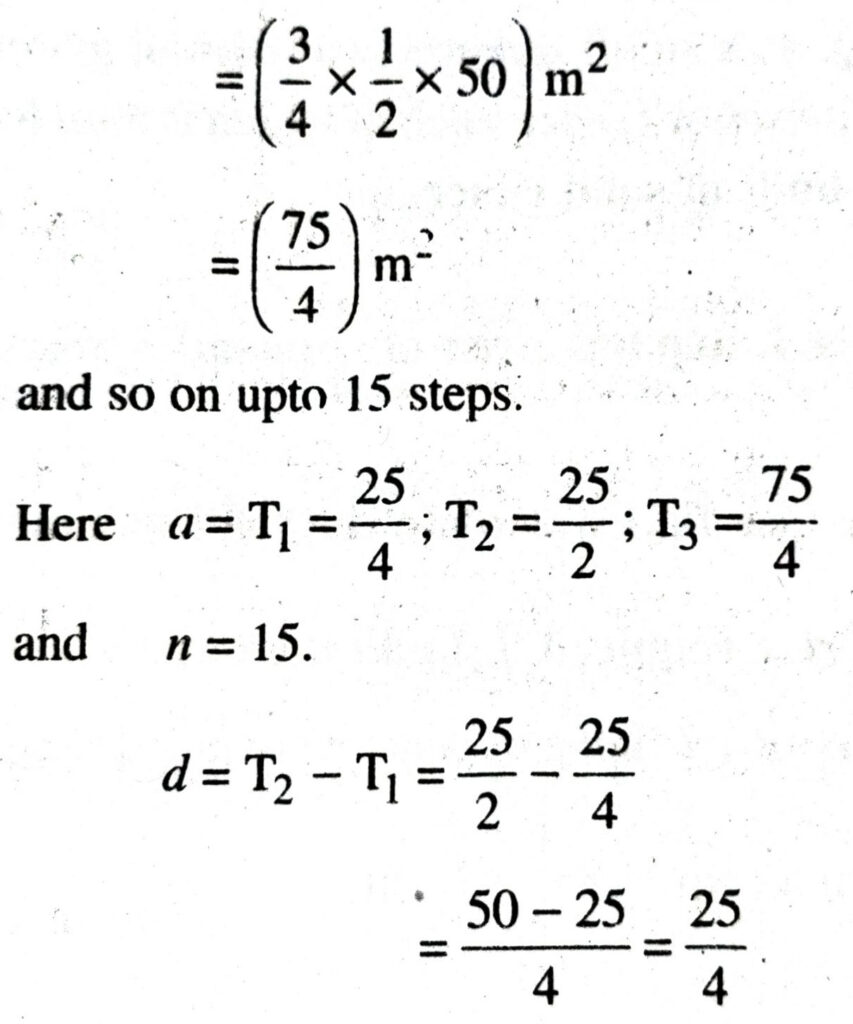
Total volume of concrete required to build the terrace
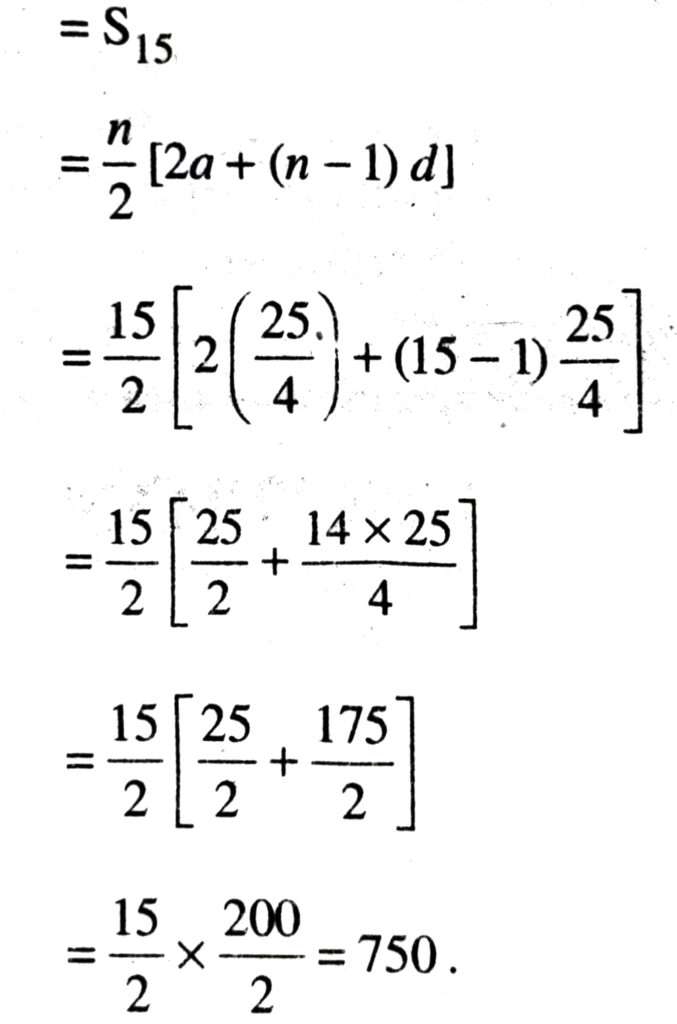
Hence, total volume of concrete required to build the terrace is 750 m³ Ans.
Follow on Facebook page – Click Here
Google News join in – Click Here
Read More Asia News – Click Here
Read More Sports News – Click Here
Read More Crypto News – Click Here